Al-Qadim: Land of Fate by Libertad!
Introduction & Chapter 1: Lay of the Land
Original SA post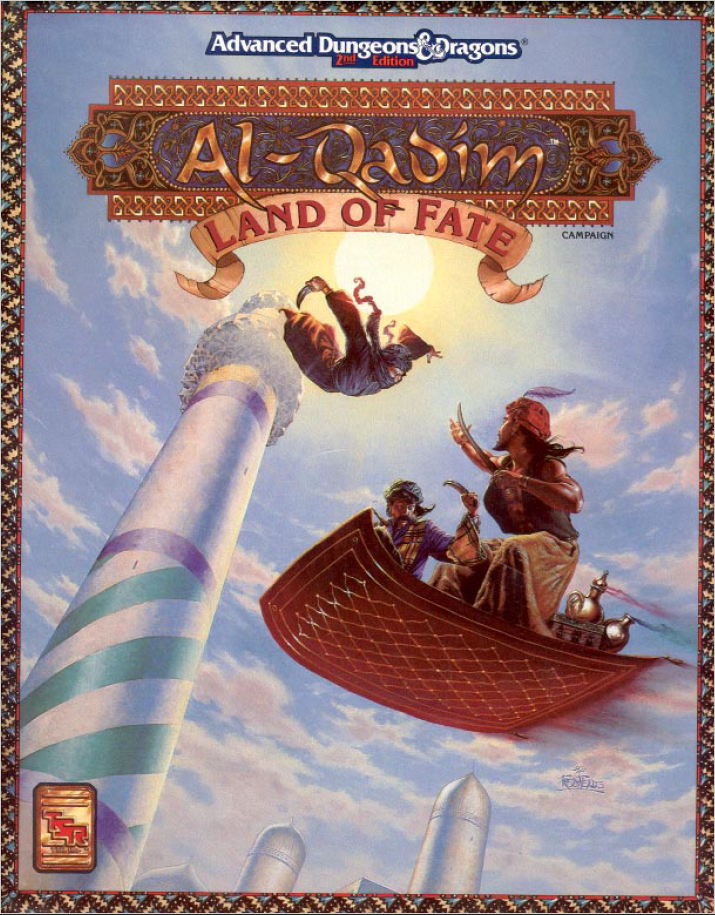
Hello everyone! I’m back from my writing hiatus, and as promised my next review is for one of 2nd Edition’s more innovative settings. First published in the early 90s, Al-Qadim drew heavily from Arabian Nights and Middle Eastern history. Its first sourcebook, Arabian Adventures, was light on setting but heavy on rules mechanics. In fact, the book was first pitched as more akin to an “Oriental Adventures” setting-neutral supplement than what was planned to be a full world. This was in part because the writers worried that the suits at the time would judge such a project too risky. The line lasted for 6 years, producing 3 supplements, 2 boxed sets, and 9 adventures both stand-alone and serials. Al-Qadim never got updated for future editions, although there’s been fanmade conversions for 3rd Edition and one in the works for 5th Edition courtesy of the Dungeon Master’s Guild.
For this review, we’re going to cover the Land of Fate boxed set, which was the supplement that propelled al-Qadim into a full-fledged world.
Introduction & Chapter 1: Lay of the Land

As a boxed set, there are three booklets of varying length and a series of handouts and maps. Adventurer’s Guide to Zakhara is both player and DM-friendly, covering the world of Zakhara. The second book, Fortunes & Fates, details DM-centric things such as hidden intrigue and secrets along with organizations and new magic items. We’re going to cover the Adventurer’s Guide first, although in some cases we’ll slip in Fortunes & Fates material which shows how things really are in our respective regions and cities. Finally, Land of Fate is a mini-sourcebook which has new monsters. As I own the electronic copy, all of these are present as their own PDFs.
Our first chapter is surprisingly a geographic glossary of sorts. There’s mention of features which may not be common in more standard Euro-style settings, such as different names for sand dunes and their functions, along with terms such as a kavir (salt flat overlying a sea of mud) or a haram (a general term for a holy site or place of power). The book references specific places as examples encountered for such terrain and places.
Chapter 2: Life in Town

Here we have an overview of common customs and daily life for the people of Zakhara, which is also known as the Land of Fate by its people. Zakharans are more or less divided into two major cultural groups: the al-Badia, who are nomads, and the al-Hadhar who primarily live in cities and outlying towns and villages. The al-Hadhar are more populous than the al-Badia, and most Zakharan cities lie along rivers and coastlands while the al-Badia are most prominent around the two inland deserts.
In the cities, there are regular calls to prayer spaced around major points in the day (sunrise, mid-day, sunset, etc) often signaled by a gong or other loud device from a mosque. These religious sites are often placed in the geographic center of a settlement for efficiency and often serve as a meeting or gathering place for the community. Most occupations relate to food production, particularly in rural areas, and agriculture makes ample use of irrigation to make up for arid environments that are common in Zakhara. Most people do not own the ground on which they live; instead it is owned and managed by local nobles and officials.
Many forms of merchants and artisans often operate their place of business right out of their homes. Musicians, story-tellers, and entertainers are another well-received occupation, and the best of the best may be lucky enough to be hired on as private performers for the nobility.
Meals are taken quite seriously. Dinner is often the largest and most important, and it’s common for the head of the house to first thank the gods for providing them with sustenance, and richer households may have multiple courses. Bread, olives, coffee, and dates are common among all social classes, while well-to-do people may supplement their diet with fruit jam and meat.
Clothing varies based on religion and culture, although there are some commonalities. Trousers and overshirts with sashes are favored by working-class men (no mention of what working-class women wear), with sandals and leather slippers when leather boots cannot be afforded. Headgear often is a soft cap or headcloth, while turbans are common in the central cities. Those who make their living in the desert wear keffiyehs and agals, and women often wear shawls whose material and jewelry is indicative of her class status. The middle and upper classes have more decorative clothing, with purses containing money, tobacco and small weapons in their sashes, and leathering stockings attached to trousers. A kaftan may be worn during times of unfavorable weather. The upper classes are fond of gemstones and gold thread, with turbans wrapped around fezes for men to make them appear taller, and it is common for servants to carry their personal belongings. Veils are common among both genders, with some places having only men or women commonly wear it. Veils are worn differently by region: nobody wears veils in the Cities of the North, the Pearl Cities are highly transparent and decorative, and the League of the Pantheon has veils which obscure one’s face. In Afyal tradition mandates that women have a veil at all times, but they don’t necessarily have to wear it and is thus usually hung over the belt or sash. Mamluks do not wear veils, for their facial tattoos demonstrate which order of slave-soldiers they belong.
There are regional differences in clothing. Dyed fabrics are common in the Pearl Cities, given the inhabitants a wider variety of colors. In the conservative Pantheist League, jewelry is forbidden as are colors other than black, and men and women alike dress in full-length robes with veils to prevent attractive people from inciting lustful thoughts in onlookers. The Cities of the Heart, sitting at the relative center of the Caliphate, have a cosmopolitan array of styles. The Ruined Kingdoms, rural areas, and island settlements often have fashion several years out of date. Even Afyal, which is a financially rich realm, is often remarked for having fashion that went out of style during the era of the Grand Caliph’s grandfather. The Cities of the North, which have the most frequent contact with “Northern barbarians” have more exotic fashion.
When it comes to governance, Zakhara is the term for the peninsular subcontinent, but the Caliphate is its official name. It is an empire whose leader holds lineage to the First Caliph, responsible for rediscovering the Law of the Loregiver and spreading Enlightenment to the world. The Caliphate functions via a form of feudal federalism, where the empire as a whole is governed by the Caliph’s law and that of the Loregiver’s teachings, while smaller provinces and city-states swear fealty to the Caliph with minor sultans, kings, and other forms of governors administrating on a regional level. Below even them are qadi, or judges, who act as local arbitrators and mediators for disputes and the dispensation of justice. Among the city-dwellers they are often appointed by existing bureaucracies, but among nomads they are often appointed by the community directly based on support and trust. Leadership roles among nomads in general is often more informal and closely-bound at the local level.
For war and military matters, most nomad tribes have many among their number who can defend themselves. Most cities have militias that can be called up in the event of an invasion, and a watch for internal policing. Some larger cities can make do with a standing army or hire out mercenaries, and mamluk units are their own division of elite soldiers. Theoretically speaking the Caliph can call upon soldiers across Zakhara in a single unified army, but they have no neighbors who can seriously challenge them in the ways of symmetrical warfare. Most small-scale battles and skirmishes are often land disputes between local authorities, or Unenlightened barbarians and pirates around the Caliphate’s borders and more isolated regions. Twenty years ago there was a local sheikh who tried to lead an army against the capital city of Huzuz, although a single mage summoned an army of genies which wiped about the sheikh’s forces in a one-sided battle.
We get a bit of a lengthy treatise on women, marriage, and family structures. Before Enlightenment, most of Zakhara was a highly patriarchal society, and while there have been many inroads towards equality (women can and have held every position besides Caliph) there are still some lingering holdovers. Men are encouraged to be financial breadwinners for family units, while women attend to domestic affairs. Women and children also have their own separate quarters in many houses known as the harim, which can range from a single room or an entire complex based on the wealth of the family. Marriage is traditionally one man, one woman, with class and financial obligations often playing a role. Men are given more freedom to marry below their station, although it is possible for both husband and wife to hold property separately. Men are permitted to have as many as four wives, although this is a steep financial obligation which only a few among the wealthy take advantage of. There’s an exception on the island of Afyal, where women can have any number of husbands; this is due to the fact that the island’s men are mobile traders, and the wives often manage the mercantile houses.
One of al-Qadim’s more controversial setting aspects is slavery. Or rather, its portrayal of the institution as one which is largely non-evil beyond some bad apples. In Zakhara is not chattel slavery for life, but more often a form of indentured servitude for law-breakers, debtors, and of Unenlightened people. The children of slaves are considered to be born free, they cannot be left to the elements if they become crippled or useless, and torturing and starving slaves may allow a qadi to rule in favor of their freedom. Any crimes committed by a slave are the owner’s responsibility.
Slaves among the Unenlightened are mostly drawn from isolated tribes among the southern islands, mountain regions, and deserts who are captured by slave-hunters. Unlike the above their children are also slaves if they reject the Law of the Loregiver. In some more lawless provinces unscrupulous slavers capture Enlightened people far from home, claiming them to be heathens pretending to be civilized.
Mamluks are the most famous and privileged of slaves in Zakhara. They are all technically owned by the Caliph himself and employed by the state as soldiers, often kidnapped from the Unenlightened and indoctrinated as children to become loyal warriors. In the northern cities bordering the Great Sea they are the de facto rulers, and often war against the pirates of the abolitionist Corsair Domains.
Finally, we talk about Zakhara’s Nonhuman Races. Zakhara holds a human majority, but all of the Player’s Handbook core options are present, along with some of the more monstrous humanoids such as goblins, kobolds, lizardfolk, gnolls, and even locathah and merfolk in seaside and undersea settlements. Unlike many other D&D settings of the time, there was no major strife between such races. In fact, most demihumans and humanoids living in Zakhara more or less assimilated and share the same customs, deities, and ways of living. However, the races still retain their original languages, which implies that at one point there were distinctive cultures, and in terms of marriage a union which can produce children’s encouraged which means that most people marry within their race* even though the Law of the Loregiver does not ban interracial marriages.
*orc-human and elf-human pairings the notable exception.
But what of races beyond that? Generally speaking, there are four main qualifiers for a monster to become accepted in the Caliphate:
1. They must be intelligent enough to understand the Law of the Loregiver.
2. They are usually humanlike in size and shape. Creatures with more exotic sizes, anatomies, and/or dietary restrictions have more difficulty living among population centers and tribes. Extremely non-humanoid monsters never become al-Hadhar, although it says nothing one way or the other about the al-Badia.
3. Their innate abilities must not be such that their powers can cause tension or discord. Very powerful and dangerous abilities can put people and local rulers on edge, even if the monster makes it a habit to only use their powers for good.
4. Certain subraces belonging to faiths and civilizations which are on a war footing with the Caliphate, or whose number have been shown to be continuously and irredeemably evil (such as sahuagin and yak-men) are never allowed to join Enlightened society.
Speaking of ‘irredeemably evil,’ I am a bit curious about this point. Although far enough away that it may as well be its own setting, Zakhara is part of the planet of Abeir-Toril which itself houses the Forgotten Realms setting. And said setting has pretty much every D&D trope with which we’re familiar, including monsters which are naturally inclined towards evil. This has included humanoid numbers such as orcs, and there isn’t really any description on how Zakharan society overcomes this trope. It seems to me that the implication is that the Law of the Loregiver is such a revelation of truth and wisdom that it can break down ignorance and hidebound customs. But then I have to ask what is it about sahuagin which makes them innately evil that they cannot be converted, whereas orcs and gnolls can break free of such tendencies.
Thoughts So Far: The Land of Fates’ opening chapters feel at once both big-picture but also focus on the day-to-day lives of its citizens. I do like the attention to detail on various things, from leisurely activities to food, clothing, and governance. It’s something even a lot of settings today forget to include, and as such makes al-Qadim feel more “lived in” than your average fantasy world.
It may more reflect the media I consume, but I find it rather novel even near 30 years later to have a setting with an empire that is not evil. And even moreso, one which does not have any major enemies militarily speaking. There are foul cults, rampaging monsters, and rulers mad with power, but Zakhara isn’t in any great danger from a Mordor-like invading army. Even the Lands of the Yak-Men and Brotherhood of the True Flame, who are al-Qadim’s most iconic villains, tend to act more via magical spies and “rotting from within.” While there are plenty of ruins and dungeons, conflict in al-Qadim would likely be of a more personal nature, and while there are problems in the system, the government’s highest echelons and Grand Caliph do genuinely care for the welfare of the people.
The aspect of slavery being an institution that is not portrayed as innately evil or in a “kinder way” is one of al-Qadim’s more controversial options, the other being honor-killing for infidelity (which isn’t mentioned in this book but in Arabian Adventures). While most D&D settings often portray slavery as the chattel kind, the various limits/protections are reflective of attempts in the Islamic world to reform the practice. Even so, slavery as a whole no matter the civilization has been too open to abuse that I am not exactly keen at seeing it ‘softened,’ morally speaking.
Join us next time as we cover the nomadic side of things in Chapters 3 and 4!
Chapter 3: Life in the Desert
Original SA post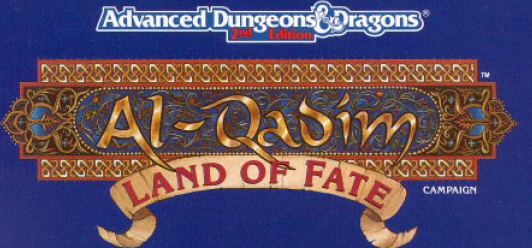
Chapter 3: Life in the Desert

This is a rather brief chapter, focusing on how the al-Badia people live. Zakhara is dominated by two major deserts: the High Desert and the Haunted Lands, and besides a few examples no large cities exist given that what few sources of water there are. All recognize the deserts’ dangers, but the al-Badia can see the beauty of the land. Nomad tribes heavily rely upon trade and livestock for survival: sour milk, roasted desert rats and lizards, and dates are common sources of food, and in lieu of water people wash with sand for hygiene. Dogs and falcons are commonly used for hunting prey, particularly gazelle, and it is customary to pray to Fate and the gods before going on an expedition to raise one’s chances of success. A unique and rare food known as “nomad’s bread” is regarded as a delicacy by the al-Badia, cooked from unleavened dough tossed into a campfire before being cleaned of ash and sand and dunked in a cup of butter.
Al-Badia tribes have seasonal routes where they pick up stakes and make voyages to nearby towns and cities, selling the various goods of their people (wool, livestock, textiles, etc) to in turn buy items they cannot ordinarily obtain on their own. They often graze off the land, and when camping arrange their tents so that they’re within easy hearing range of warning horns in the event of trouble.
For what they cannot (or will not) trade for, they often obtain in raids where hunters will ride at night or during a dust storm to steal cattle from another tribe. This is meant to be a non-lethal affair, where those who remain in their tents are untouched and combat is not to the death, with signs of surrender known to almost all tribes to ensure that such raids don’t devolve into blood feuds. City-dwellers have no love or understanding for such raids, so nomads who attack villages and outposts often escalate things into bloodier affairs. More sensible and honorable tribes discourage this practice unless times are truly lean.
Nomads recognize laws of hospitality much as city-dwellers do, although the traditions are different in some ways, such hanging up a frock at a tent’s front to celebrate a guest’s arrival. It is during this time that the al-Badia have mutton as a feast, for sheep are delicious but their wool is an important trade good. Marriage (and divorce) are more informal as well, where a husband simply declares his desire three times while in the woman’s case she returns to her parents’ home. Babies are often decorated with blue-beaded caps, kohl on the face, and a dagger by the side of their crib in belief that such things protect them against the evil eye, a unique type of curse in Zakhara which is often bestowed by genies who become jealous of mortals who are too obviously arrogant.*
*This has mechanical rules in Arabian Adventures, and as a result causes most Zakharans to make shows of humility when they are praised in public.
It goes without saying that camels are a common herd animal among the al-Badia, as well as anyone who seeks to traverse Zakhara’s inland regions. They can endure the heat and poor resources of the desert, their dung can be used for fire fuel, and their urine serves as a multipurpose shampoo/disinfectant/eyewash/laxative.
Honestly, I am a bit surprised that there’s no mention of horses. In real-world Arab societies horses played an iconic role more so than camels, and served as a status symbol and were used for a variety of roles from racing to war. Camels were more typically draft animals.
Chapter 4: Desert Tribes
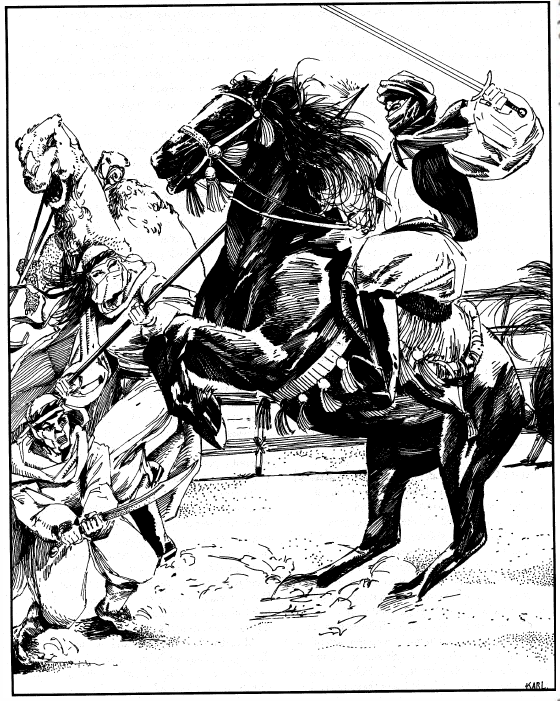
This chapter covers the major groups of al-Badia, split up into tribes of the High Desert and the Haunted Lands with nine among the former and three upon the latter. There are hundreds of smaller tribes which are little more than individual bands and extended family units, while the major tribes can number thousands of people (and ten times as many livestock). The tribes of the Haunted Lands by contrast are fewer in number, and their region is more highly elevated above sea level. Said desert was once home to warring kingdoms, and it is an important trading route connecting the eastern Ruined Kingdoms to the League of the Pantheon.
A Note on NPCs: It is with this chapter that we begin to see a common trend in the al-Qadim setting. Although none have full stat blocks, Zakhara is similar to Forgotten Realms in that its important figures tend towards the higher levels. Most city rulers and tribal leaders are quite high level, ranging from the low 10s to 15 and higher. Levels 5 to 10 are usually the sons and daughters or more minor yet notable figures in court. But unlike Forgotten Realms, most such figures tend to the interests of their hometowns primarily (or themselves for the less scrupulous sorts); nobody exceeds 20th level, and there’s no Elminster or Seven Sisters’ equivalents going around Zakhara and righting wrongs. Even the Grand Caliph and his court usually delegate matters to local rulers instead of intervening directly, using the empire’s bureaucracy and institutional power to alleviate injustices.
Tribes of the High Desert
House of Asad (Children of the Lion) are one of the more prosperous tribes of the High Desert, and this in turn makes them quite arrogant. They claim a notable Jamal Oasis as their land but let other Enlightened tribes make use of it. Their leader, Sheikh Najib bin Kamal al-Asad, is one of the few 20th level NPCs in the setting and is known for being unmatched in combat.
House Bakr (Clan of the Young Camel) mostly live in and nearby Tajara, one of the cities of the Pearl. Their leader, Sheikh Ali al-Hadd, is the son of one of the rebels against the city’s ruler, who saw a vision that the people of his clan would know only misfortune within its walls. As said leader was formerly a prominent officer, relations between House Bakr and Tajar’s government are strained.
House of Dhib (Sons of the Wolf) live mostly as craftsmen and herders, but are notorious raiders of caravans and use old qal’ats (ruined fortresses) in the mountains to store their ill-gotten gains. Many such strongholds are believed to be magically warded from conventional view. Its leader, Sheikh Anwat al-Makkur, is gaunt to the point that he’s nicknamed “the Skeleton.”
House of Dubb (House of the Bear) live in the southwest portion of the High Desert, and also harvest the woodland resources of the Realm of Bleeding Trees. Its leader, Sheikh Yaqub al-Quwwat, would much prefer to go out on adventures than attend his traditional duties. He has also fallen in love with the city of Ajayib’s ruler, in part because he is still unmarried without children and was told of a prophecy that he does not have long to live.
House of Nasr (People of the Eagle) are well-known for maintaining the Desert Mosque which is holy to all nomadic tribes. The clans among the house serve yearly rotations where they watch over the mosque, and its leader Sheikh Nadia umm Fadela is famous for protecting it from foreign raiders. She is also known for single handedly rescuing her daughter from a band of mamluk slavers from Qudra. Said daughter has red hair* and was thus mistaken as an Unenlightened barbarian. This was all settled amicably once the mistake was revealed, and the responsible mamluks were assigned to the less-prestigious naval units of their city
*which calls the marital faithfulness of Sheikh Nadia into question in very whispered hushes.
House of Sihr (Jann of the High Desert) are not humanoid at all, but rather janni who live in the most inhospitable region of the High Desert: the appropriately-named Genie’s Anvil. They are a diverse gathering of clans hailing from faraway lands, some serving greater genies and others independent. They live much as other al-Badia, albeit with more magical abilities in common use. Their leader, Amir Bouladin al-Mutajalli, oversees a group of lesser sheikhs who regard themselves as the most important clan, and his daughter is often fond of disguising herself as a mortal and accompanying adventurers to fascinating locations.
House of Tayif (Ghost-Warriors) are Unenlightened, and their major stock in trade is raiding other tribes and appear to only seek violence against trading caravans. Its leader, Mouli al-Ajami,* is a blonde-haired, blue-eyed foreigner who seeks vengeance against the Caliphate for his capture and torture at the hands of Qudran mamluks. Interestingly said foreigner is a Paladin, and given that this is pre-4th Edition where they could only be Lawful Good, this makes me wonder if there’s some deeper tale to tell behind this. Anger at Qudra’s military is understandable (they aren’t above using under-handed measures against their fellow cities as we’ll find out in Chapter 7), but the tribes’ portrayal sounds like they’re attacking a much wider audience than the mamluks.
*Ajami is a Zakharan term for ‘foreigner.’ Another foreign NPC in this book also has this title.
House of Thawr (Children of the Bull) had the majority of their number settle into more sedentary lives in the Pearl Cities. The remaining nomads have been on the receiving end of attacks from said cities after some unsuccessful raids. Its leader, Sheikh Ali al-Sadid, has refused various plans from advisors, instead placing his trust in visions of a “cleansing wind” that shall destroy the cities. His daughter worries about her father’s sanity, and has pressed the ablest members of the tribe into scouring dungeons and ruins for valuable treasures to uplift themselves out of poverty.
House of Uqab are technically Enlightened and pledge loyalty to the Grand Caliph, but they are made up of outcasts from the other tribes and not hospitable to strangers. They have even been known to recruit Unenlightened tribes from the mountains, but often employ them as expendable mercenaries on the front lines of raids. Their leader, Solina al-Ganij, is a powerful fire mage and former member of the Brotherhood of the True Flame who is on the run after a failed assassination attempt against the sultana of Hiyal.
Tribes of the Haunted Lands
Unlike the High Desert, these ones have no alternate names in parenthesis.
House of Hanif are the largest tribe and whose center of governance operates out of a qal’at once home to an order of holy slayers. They are loyal to the Caliph and even have their own ambassador in Huzuz. The leaders’ two sons differ on their relationship to the Grand Caliph, with one entranced with the courts’ wonders and marvels of the city-dwellers, while the other feels that they are too much under the al-Hadhar’s thumb and advocates building their own city. Both sons have advocates among the tribes, which may lead into an ideological split.
House of Hotek have a legendary rivalry with the City of Hiyal. The greed and treachery of the latter’s governance has earned them many enemies, and the House’s numbers increased exponentially from those who lost everything from Hiyal’s sultana. Its leader, Ibrin bin Hotek, seeks to destroy the city and the evil legacy of its rulers, and leads many raids against its holdings.
Jann of the Haunted Lands tend to be more erratic and quick to offense than their counterparts in the High Desert, which causes most to avoid them unless they have no other option. They once lived in a grand civilization known as the Great Anvil, but its buildings are now charred ruins among the desert. Many people theorize that this is the reason for their violence and paranoia. They used to pledge loyalty to every new Grand Caliph for the past 14 generations, but as of today no jann diplomat has been sent to Huzuz’s court. Its leader, Amir Heidar Qan (who has no HD or level listed) has not been seen in 50 years, and if he’s alive he acts only through servants who claim to speak in his will.
Thoughts So Far: I like how the al-Badia clans have enough detail that virtually each of them has an adventure hook of some kind or an interesting ally or backstory for a nomadic PC. There’s quite a bit of talk on the ‘mundanities of life’ which I touched upon in my last entry. Unfortunately, we don’t have much more info on nomads beyond these chapters, for the rest are by and large dedicated to the al-Hadhar cities of Zakhara.
Join us next time as we cover Chapter 5: Gods & Faiths!
Chapter 5: Gods and Faiths
Original SA post
Chapter 5: Gods and Faiths

This is the big chapter on religious beliefs in Zakhara, Enlightened and otherwise. Society recognizes three major groupings of deities, which is more of a cultural designator than an objective cosmic fact: Major or Great Deities, who are universally (or near-universally in the case of the Pantheist League) worshiped in the Caliphate; Local or Common Deities, who are those considered legitimate by the Law of the Loregiver but have smaller followings; and Savage or Heathen Deities, a catch-all term for foreign gods who do not recognize the Law.
Religion in the Caliphate functions differently than in other D&D settings; people often pray to the gods as a whole, choosing specific deities as favorites based on their circumstances, occupation, and other factors. Divine spellcasters of organized churches often, but not always, give the majority of their devotion to a single deity. Furthermore, the eight Major deities have no alignment; alignment is instead based on the priest kit* rather than one’s patron deity, and instead they reflect universal archetypes which can be found in both the noblest hero and foulest villain. Local and Savage Deities are closer to basic D&D where they have specific alignments which the majority of worshipers belong to.
*2nd Edition terminology for a subclass.
Beyond the gods themselves, the aspects of the Caliphate’s religion speak a lot about Fate. Fate is not a god or entity (although she’s portrayed as a personified woman in some tales) so much as a universal force of nature which affects all things. The Loregiver was a long-ago mortal woman who served as an interpreter of Fate’s cosmic threads. She penned the Law which would serve as the building blocks for moral society, and the gods who saw its wisdom came to be known as the Major Deities, with later-comers known as Local and Common Deities.
Zakharan religion has some Islamic influences, as you might imagine. It is customary to kneel to the ground during prayer, although in some cases bowing one’s head silently is accepted. Prayer itself which is held at different times of day based on the position of the sun and moon. Worshipers pray in the direction of the capital city of Huzuz, and much like the pilgrimage to Mecca it is customary for the Enlightened to visit the Golden Mosque there at least once in their lives. There’s nothing in the Law which mandates that prayer and sermons be held at temples; barring centers of supernatural power, centers of worship are a more practical affair constructed to strengthen community bonds as well as have a common point of reference in a settlement.
Note: The text makes reference to class kits from the Arabian Adventures sourcebook, which I’ll discuss here. Clerics are grouped by the same faith rather than individual gods, and there are no “specialty priests.” Specialty priest is an AD&D term for clerics with their own Spheres which were not unlike later Edition cleric domains. Priests of Order were part of a hierarchical church and grouped into Pragmatists (most liberal and tolerant, in touch with the common folk), Ethoists (more conservative, the ‘baseline/mainstream’ religion in Zakhara), and Moralists (preach the supremacy of their individual deity over all others). The differences between Order Priest Kits are political in nature; they all have access to the same kinds of cleric spheres even if they favor a particular Enlightened god, and ethoist and moralist priests are able to get various social boons such as safe havens, room and board in temples, monetary loans, hired help and special assistants, all in exchange for being bound by the bureaucracy and hierarchies of their church. Moralist priests get more political boons in exchange for more restrictions. Pragmatists may be any alignment, ethoists any non-chaotic, and moralists have to be lawful.
Free Priests do not belong to an organized faith and whose kits include Hakima (women with second sight and truth-telling abilities), Kahins (idol-worshipers who believe in a universal divine force), and Mystics (ascetics who gain divine insight through trance, meditation, and introspective activities over rote prayer and learning).
Great Gods are the eight major deities of Zakhara. Each entry (including the following Local and Savage Gods) has formulaic listings of holy symbols, special abilities only their priests gain if any (usually +1 to a certain ability score), permitted weapons beyond basic cleric proficiencies, as well as where their centers of worship are most common.
Hajama the Courageous represents courage in all its forms, and not just the kind in battle. He is popular in areas of harsh terrain and where conflict is common. Hakiyah of the Sea Breezes is associated more with wisdom and truth than the sea, viewed as a wise mentor figure. She encourages the faithful to be skeptical and to never be certain or content with how things are, but also to not act rashly or with immediateness. Haku, Master of the Desert Wind, is closely associated with nomadic culture and preaches a doctrine of self-reliance. Jauhar the Gemmed is only considered a Great God in the League of the Pantheon, a goddess of industry who encourages the accumulation of wealth as the ultimate means of bettering oneself and the community. Jisan of the Floods is a goddess of fertility and agriculture, who is theorized to have once been a storm goddess in pre-Enlightenment times. Kor the Venerable is a god of wisdom, order, and stability and is thus often portrayed as a wizened old man who uses a hatchet to metaphorically attack “the root of the problem.” Najm the Adventurous is a deity of uncertain gender who is associated with curiosity and daring deeds, and whose priesthood are the most likely to travel the world to experience its wonders and to bring word of the Law to foreign cultures. Selan the Beautiful Moon is a goddess of beauty and joy, patron of the night sky. Her chariot pulls the moon across the horizon, followed by her mainy suitors who take the form of stars. Finally, Zann the Learned encourages learning and the written word, for knowledge is best utilized when spread far and wide. His followers are heavily involved in the creation of libraries and centers of learning, although they have a bias against texts from heathen cultures and presume them to be works of fiction. Which seems like a pretty huge hurdle in their ideology.
Gods of the Pantheon is novel in that it gets its own entry not as a deity, but as a religious movement. Holding sway over a group of cities collectively known as the League of the Pantheon (aka Pantheist League), they recognize only five deities out of eight as being Enlightened. Pantheist teachings view Hakiyah, Haku, Jisan, and Zann as being less than sincere, merely wishing to join the winning side, and consider one of their local gods Jauhar to be a Great God instead. This is of course disputed by other political and religious factions, although as of now they coexist in a tense peace. Only Pantheon-approved deities are allowed to be worshiped in their mosques, and members of even other Enlightened deities face heapings of legal persecution which drive their faiths underground. The gods themselves have not weighed in as to the correctness of the Pantheon one way or the other.
Local Gods are highly numerous in the Land of Fate, although this boxed set only details 4 entries. They usually have strong ties to a tribe, holy site, or other geo-political center. They include the regular priest kits of al-Qadim plus the specialized idol-worshipers known as Kahins. Kahins are Zakhara’s equivalent to druids, who share an animist-like belief that divine power is present in all things. Kahins are believed to belong to some of the oldest religions in Zakhara, and are known to worship physical objects in addition to deities in order to gain their powers. Their practices encourage moderation and balance, and have no organized churches or hierarchy.
Bala of the Tidings is a goddess of music, whose worshipers suffered major losses in a war with the League of the Pantheon. Their religious center was the city of Mahabba, and small groups of holy slayers avenge themselves on Pantheist officials. Bala’s faith encourages the use of song and music to make people strive towards good works, but now most people know of her through violence and thus call her Bala of Ill Tidings.
The Temple of Ten Thousand Gods is a religious movement that recognizes all deities, both Enlightened and heathen, to be various faces of a single god whose presence manifests in different ways to different people. The movement is tolerated in the Caliphate, although moralists insist that they’re a false religion or a mere philosophy without a god (but they receive cleric spells all the same). Priests of the Temple of Ten Thousand Gods are a small, decentralized religion whose few tenets include universal tolerance (“all are touched by holy radiance) and to learn as much about as many gods as possible.
Vataqatal the Warrior-Slave is common among the northern mamluk-ruled city-states, hailed as a martial paragon who encourages enlightenment through self-betterment through conflict. His status as a slave, a servant in defense of the Enlightened, makes him popular among mamluks and soldiers in general who admire self-sacrifice in favor of a cause.
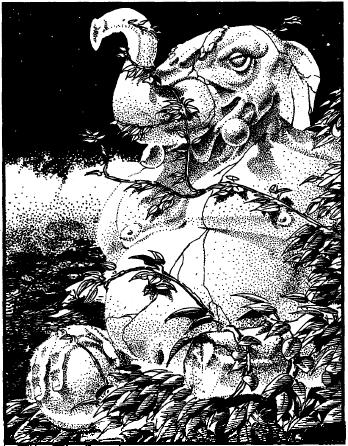
Savage Gods covers those gods who come from beyond the reaches of the Land of Fate. Ignorant or willfully defiant of the Law of the Loregiver, their faithful are usually only encountered as lone foreigner priests visiting Zakhara or as isolated tribes and cults. Some are merely forgotten, legacies of long-ago civilizations whose people died off or converted to Enlightenment. For the dead faiths we have five entries, although one you may recognize is Lotha, a spider goddess worshiped by evil elves who were burned at pyres for their sinful ways long ago.
Those with living faiths are common in the islands of the Crowded Sea, and can range from mortal heroes whose tales elevated them to divine status or merely very powerful monsters and genies playing godhood. One of the more detailed island-gods listed includes the Lost One, an elephant god of the Isle of Afyal, whose influence makes his favored animals more intelligent than usual in that realm. Other entries include Kar’r’rga, a crab-headed giant whose protects several coastal villages from attacks, the Drummer who when summoned to the world by music tears through a tribe’s enemies as an invisible force, and Pag a nature god whose spirit is said to inhabit every bit of flora on an island and thus whose worshipers eat only meat and seaweed. I do like how Kar’r’rga and the Drummer can be divine interpretations of existing monsters and spells; the idea of bards shooting sonic blasts with their music they believe is their god helping them is a rather cool mental image.
The Hill Tribes are heathen people who live in Zakhara’s highest altitudes, and whose gods are considered to be particularly wild and violent. Legends teach that their gods ruled as lords in far-off lands, but were exiled for their crimes to the wilds of Zakhara. Two of the most well-known Hill gods include the Beast, a catlike being who hunts children far from home, and the Faceless God of the yak-men who teaches his people the art of civilization but only so that they can dominate others.
Cold Gods of the Elements are the very same four elemental deities from the baseline Forgotten Realms setting: Akadi (air), Grumbar (earth), Istishia (water), and Kossuth (fire). They are dubbed ‘cold’ more to their aloof attitude towards mortal worship than an association with ice, and are commonly known in Zakhara more due to their spellcasters’ affinity for genies and elemental magic than having any significant batch of worshipers. The Brotherhood of the True Flame, an evil organization of fire elementalists are particularly interested in theories and rituals which could possibly enslave one of these gods. All such attempts resulted in said Brotherhood member’s destruction at the hands of raw elemental power.
Finally, there are a few gods from the continent of Faerûn known in the Land of Fate, although their names are transliterated differently and the in-game text has a clear bias (such as confusion when a culture or pantheon has “two gods doing the same thing”). Gond is known to be worshiped by foreign traders, while Helam (aka Helm) is viewed as the warrior god of all northern barbarians due to his worshipers once assaulting the city of Qudra in an organized force. Overall, Zakharans view Faerûnian deities as being inordinately selfish for demanding exclusive worship even for small areas of influence, and find the concept of racially separate pantheons, or a god who can claim to speak for an entire race or species, to be a bizarre concept.
Thoughts on the Chapter: I’ve never really been a fan of D&D’s standard monolatrism, where they have a pantheon styled in the Greco-Egyptian manner but then have clerics exclusively worship one god. Although there are still some holdovers, al-Qadim posits game mechanics as well as a society which can house a more typical ‘worship the pantheon’ style. I am a bit amused at how the setting kind of wants to borrow inferences from Islam but doesn’t go full monotheism, and while I appreciate that there’s diversity of thought even among believers it does stretch credibility a bit. Why is the Temple of Ten Thousand Gods not viewed as heathens in disguise beyond just the League of the Pantheon, if they view all deities as equally legitimate? And why are the gods tight-lipped about the whole contention thing regarding the Pantheon’s religious interpretations? I can see this playing out in one of two ways:
1. The Great Gods are united and truly devout, and the Pantheon’s suspicions are a bunch of huey but their political power and latent zealotry can very well cause civil war to break out with the wrong words. So the gods end up saying nothing to preserve an uneasy peace.
2. There may be division and suspicion among the gods both Great and Common regarding purported devotion to Enlightenment, but do not proclaim things one way or the other to avoid civil war in the Caliphate and among their own divine number.
Both options are logical, although given the Caliphate is a centuries-long institution it begs the question of why such issues haven’t been resolved or what’s tying the gods’ hands that they can’t just say an ultimatum to be accessed via the Commune spell. Granted, in the appendix we learn that there are some questions on other subjects the gods refuse to answer, so the Zakharan pantheon may be more tight-lipped than usual.
Another thing I’ve noticed that is tangential to the setting but raises questions due to its connectivity to Forgotten Realms: there was an event known as the Time of Troubles where every god save one was demoted to mortal status, and their clerics lost their powers unless they were in close proximity to their patron deity. The al-Qadim setting takes place nearly 10 years after this event (1367 DR, where the ToT happened in 1358). The boxed set makes no reference to any sort of loss of divine power in Zakhara in recent memory, which suggests to me one of several possibilities: that otherwise planar-wide events are confined entirely to Faerûn, that al-Qadim was originally meant to be its own setting but got stapled to the Forgotten Realms (the one I believe), or the gods of Zakhara are not gods in the traditional sense but something else.
Chapter 6: Cities of the Heart

Note: Although technically in a separate book, Secrets of Zakhara details the hidden goings-on in the respective cities of this region and following chapters. I’ll highlight said secrets as part of these entries as a sort of “all in one” coverage.
The relative geographic center of Zakhara, the Heart is home to the capital city of Huzuz and is thus a sort of melting pot of the rest of the Caliphate. Four major cities dominate the Heart, three of them lined up against the shores of Suq Bay with Halwa deep in the deserts to the east.
Halwa, City of Solitude: Located inland on a bluff deep in the deserts, Halwa is far from other major population centers. Its wadi* turns into a muddy torrent roughly for a month around springtime. It serves as a trading center between city-dwellers of the Heart and the nomadic tribes of the Haunted Lands. Caliph Hava al-Gatil rules lightly in most affairs, and the city’s a center for adventuring parties mounting expeditions into the Haunted Land’s many fabled ruins. Chief Vizier Zarad is the power behind the throne, often misusing his position to levy heavy taxes and gain various personal favors. He has a bound dao (earth genie) at his side he refers to as his “pet” who acts as a very powerful servant.
*Arabic for a valley or channel that becomes a riverbed during heavy rainfall.
Secrets: Zarad seeks the hand of one of the caliph’s daughters, who resents the vizier but does not act openly against him due to the watchful eye of his dao servant. Zarad also seeks immortality to live as long and pleasant a life as possible, and is not above delving into dark magic to achieve this ideal.
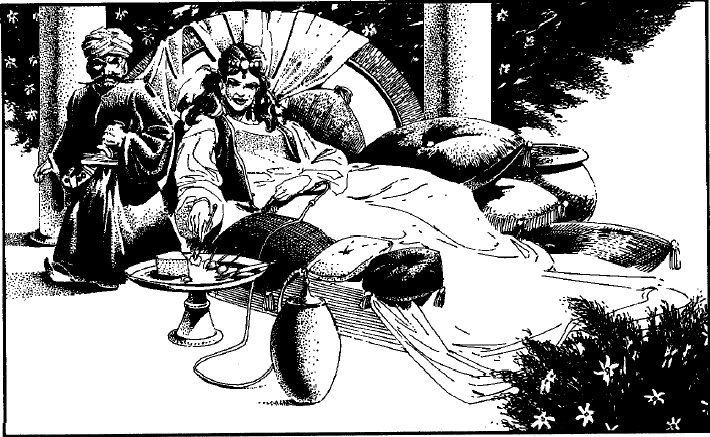
Hiyal, City of Intrigue: The closest thing al-Qadim has to an “evil city,” Hiyal is a miserable industrial hell with an ever-present cloud of pitch-black soot. Its streets are winding and haphazard, and where the tyrannical sultana’s court cannot hold sway, organized crime does. Although the people of Hiyal are no more evil than anyone else in the Caliphate, the city’s unpleasant reputation causes many outsiders to distrust them, and evil-doers in general are attracted to the land in hopes of being better able to ply their wicked ways there. Sultana Alurah bint Ashra is getting up in age and has ill health, and her immediate family endlessly fights among themselves in hopes of claiming the throne. A few even made deals with other evil factions, such as Prince Omar who joined the Brotherhood of the True Flame. There are interesting figures beyond the court in the city itself, such as a rumored ‘Shadow Marketplace’ of magical wonders which can only be entered by entering the right number of gateways in the city.
Secrets: Bulad the Steelmaker was once the finest weaponsmith in the Land of Fate, and his daughter still follows in his footsteps. Her father was murdered, and there’s suspicion that Prince Omar is the culprit given that he recently purchased most of the city’s steelworks. He seeks to use their great resources to build iron golems, whose construction was learned from savage foreigners beyond Zakhara.
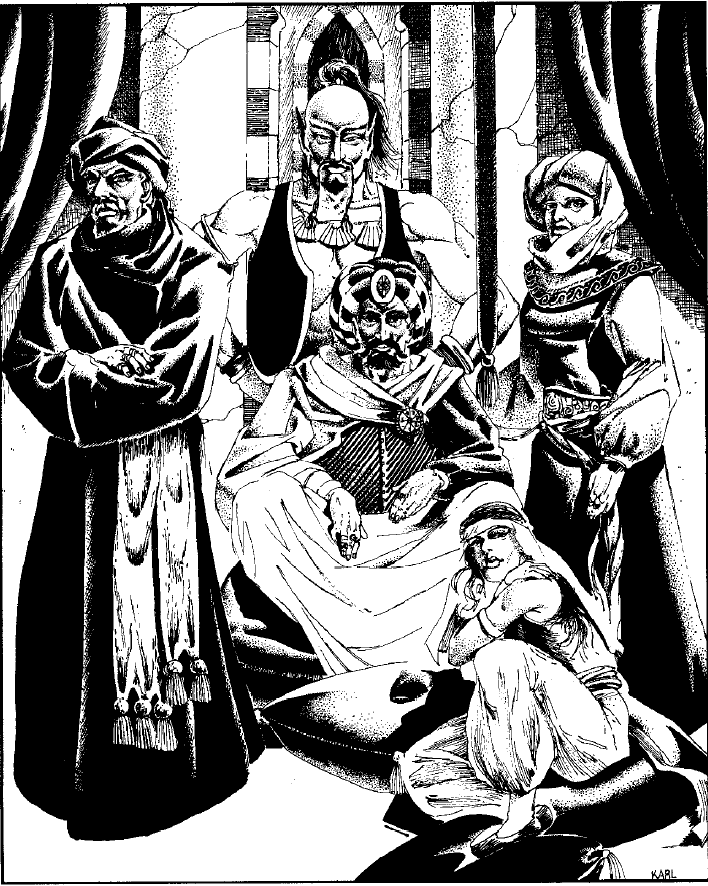
This is the ideal Lawful Good government. You may not like it, but this is what a 20th-level ruler looks like.
Huzuz, City of Delights: Sitting at the edge of Suq Bay’s south and thus within easy reach of both western and eastern Zakhara, Huzuz is considered by many to be the Caliphate’s most beautiful and wondrous of cities. It was here that the First Caliph unearthed the Loregiver’s scrolls and learned of the Law. Ever since it has been the most important political and religious center of the Land of Fate, and during certain holidays its population of 800,000 can nearly double. Its gilded architecture has given the city the nickname of Huzuz the Golden, and its residents bear influences from the rest of the continent. In addition to mortal forces of warriors, mages, and cavalry both conventional and monstrous (griffons and hippogryphs as favored aerial steeds), Huzuz employs a veritable army of genie servants bound by sha’ir to defend its walls from invasion and to provide magical aid in day-to-day life. Mages cast continual light spells upon lamps at night to allow for vision even after sundown, and nine mosques arranged in a half-moon shape are keyed to each of the Eight Great Gods. The ninth mosque, the Golden Mosque, is built around the ruins of a house believed to be where the Loregiver buried her writings of the Law.
A fair portion of this section is devoted to the Grand Caliph and his court. Khalil al-Assad al-Zahir bears many titles, all suitably appropriate for the most politically powerful man in Zakhara. A mighty warrior possessed of genuine care for the welfare of his people, there is no ‘mad, tyrannical emperor’ trope in al-Qadim nor an incompetent and out-of-touch ruler kept in the dark.
The Grand Caliph has not produced any heirs yet, to the worry of many. His uncle, Prince Tannous, oversees an expansive network of spies and would assume the throne if he dies childless. The Grand Vizier is a moralist sorceress who serves as an advisor and is often the more serious foil to Jiraad, a marid genie ambassador who oversees the genie soldiers of the city and believes that the Grand Caliph should listen to his heart in more affairs. The Keeper of the Mosques is an elderly elven priest in charge of the upkeep of the nine mosques in town and for learning of the needs of the faithful at large. He is tasked with presenting disputes and quandaries of a religious nature to the Grand Caliph’s attention.
The city’s other important figures include a barber by the name of Gorar al-Aksar who often hears many rumors of interest to adventuring types, while a senior member of the Brotherhood of the True Flame lives in a mansion which serves as a base of operations for the organization in the region.
The section on Huzuz ends with a short tale of its history which virtually anyone in the city knows: 600 years ago the land was but a small village. The man who would become the first Grand Caliph received a vision from Fate at the house claimed to be the Loregiver’s dwelling, who back then was a figure of legend. The vision told of how disaster would befall his tribe, but that they would rise to greatness if he placed his trust in Fate. The prophecy came true when a sandstorm of epic proportions hit his tribe, seemingly never-ending nor weakening in strength. The man chose to ride in a random direction on his horse, trusting Fate to protect him. He awoke later in a cave and discovered a set of ancient scrolls written by the Loregiver herself.* He shared its teachings with as many people as he could, and soon the words of the Law spread far and wide. The scattered members of his tribe miraculously survived, and re-established their ties by following the tales of the one among their number who made this grand discovery. Soon the collection of tribes following the Law grew into a collection of cities, and eventually a Caliphate, the title of Grand Caliph passed from father to son.
*So is the Golden Mosque built around a cave? Is the Loregiver’s house sitting on top of a cavern entrance? There are some contradictions, but given the nature of stories it’s likely told more for dramatic effect than historical accuracy.
Secrets: The Grand Caliph’s seeming infertility has no definite canon answer, but there are several possibilities listed: he is naturally interfile, a djinn-enchanted gem which radiates an aura preventing conception was placed in the chandelier by a courtesan who fell out of favor, he is actually fertile but his children are being raised in hiding by the Soft Whisper.*
*an all-female order of Holy Slayers who act in the interests of the Grand Caliph, although it’s uncertain whether or not they function with his approval.
Wasat, the Middle City: This city has the shortest entry by far, roughly under a page. It serves as a major trade port between Huzuz and Hiyal, but has a “sleepy and quaint” vibe of an easy-going place. Interestingly the proximity to more wondrous locations like Huzuz, its populace is rather nonplussed to all manner of crazy and epic happenings as long as it doesn’t cause too great harm. It is home to a great archmage by the name of Azuah al-Jawwaf who is a whopping 20th level, but doesn’t seem to do anything beyond conduct research in an old monastery-turned-home and serves as an advisor to the city’s ruling Caliph. The closest the city has to conflict is various spies and agents of Hiyal and Huzuz monitoring the local court in hopes of gaining political and economic advantages.
Secrets: None, surprisingly.
Thoughts So Far: Barring Hiyal, the Cities of the Heart are not exactly the most “adventure-worthy” places. Huzuz is thematic and reflective of a wondrous high-magic imperial capital, but the emphasis on its powerful rulers and being a bright shiny beacon of goodness makes it more the type of place PCs defend from outside threats than the kind in which you find homegrown threats. Wasat is kind of boring, although Hiyal has a fun vibe as a “hub of scum and villainy.” Halwa’s treacherous vizier and proximity to the Haunted Lands can make it a good base of operations for wilderness adventure, although there are other cities later on (particularly in the Ruined Kingdoms) which can serve this function better in my opinion.
Join us next time as we cover the Cities of the North and the Cities of the Pearl!
Chapter 7: Cities of the North
Original SA post
Chapter 7: Cities of the North
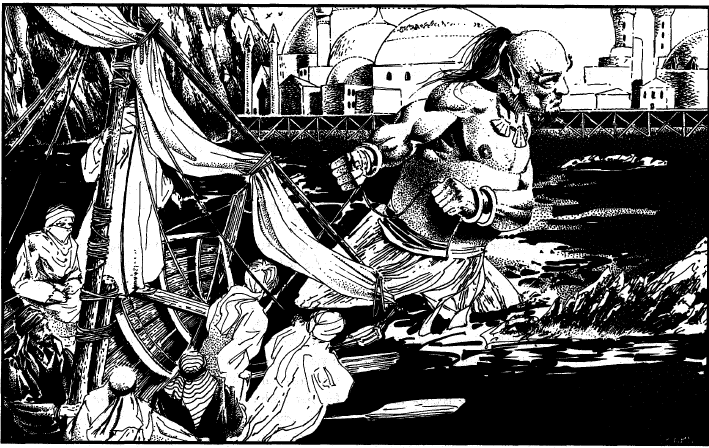
Northwest Zakhara is the region which sees the most contact with the lands beyond the Caliphate. There are three major political blocs here: the militaristic city of Qudra ruled over by mamluks; the Corsair Domains which are a loose conglomeration of abolitionist pirates and enemies of Qudra; and finally the Free Cities, six city-states who pledge loyalty to the Grand Caliph but are more likely to be self-governing the farther they are from Qudra. A minor yet no less persistent group are the Hill Tribes to the south, Unenlightened holdovers who refuse to acknowledge the Caliphate’s authority and pantheon. They are both a common target for mamluk raids looking for children to ‘civilize’ as the next generation of slave-soldiers, and also attack settlements and outposts under the authority of Qudra and the Free Cities. Unsurprisingly it’s more common for commoners to own weapons due to the martial attitude of the region. Just about every city has an unofficial color associated with it as well.
Hafayah, City of Secrets: Recent political uprisings have left a sense of unease among the populace: its legitimate heir Princes Saba is only 8 years old, whose older siblings and parents met tragic ends at the hand of mysterious assassins. He was only put on the throne when it seemed like Qudra would invade to “restore order,” and a gnome advisor by the name of Uqban min Najm rules temporarily. Uqban has close ties to local religious institutions to aid his spy network, which spends most time turning local factions against each other in order to prevent any one group from seizing power.
The city color is black, reflecting somber attitudes and mourning.
Secrets: The young prince has a fixation with abandoning politics in favor of being a classic “traveling hero righting wrongs.” Various tutors tried dispelling him of such fantasies to no success. The gnoll scribe and tutor Jamalia is responsible for his flights of fancy due to tales from her childhood. An adventure hook includes the Prince running away to live with desert nomads, and the PCs must rescue him given he has no idea how tough and dangerous this life truly is.
Hawa, City of Chaos: This is the only true city among the Corsair Domains. Half of its buildings rest upon stilts directly over the water, and the closest thing it has to a ruler is a “pirate king” who inevitably gets deposed every few years. The city council more or less rubber-stamps the pirate-king’s decisions. Much of Hawa’s local industry revolves around servicing the seabound trade, although various council members extract taxes from the population which are little more than protection rockets. Razor-sharp coral reefs capable of being terraformed by sea elf mages give Hawa a natural defense, and while wealthy members have their own private guards roughly half the populace will take up arms in the event of an invasion.
Three notable political figures in Hawa include the legendary pirate Jayan ai-Jasir who once used a zaratan as a mobile island-ship; Grima al-Auni min Kor, a hill giant priest of Kor who is an evangelist hoping to bring proper values to the Corsair Domains and protects street children from the city’s many dangers; and Akura al-Hiyali, a sha’ir pirate captain fond of using genie servants in naval battles and seeks to depose Jayani as Pirate King.
Hawa has no official color.
Secrets: A cult dedicated to Istishia (elemental god of water) is believed to be behind the disappearances of young people in the city. Grima hires the PCs to track down the missing youths and drive the cult off the island.
Liham, City of Soldiers: Liham is in close proximity to Qudra, and its standing army is supplemented by mamluks from said city. This has earned some unsavory insults among other courts of Liham being ruled by a spineless lapdog. Various rumors claim that it won’t be long before Qudra will outright move in and take over Liham, while others believe that the ruling caliph will petition the aid of other cities to make a show of force against Qudra and become truly independent. Some even believe that an illegitimate son of Liham’s caliph is in hiding, waiting for the day to come in and lead a popular revolt.
The official color is red, garments often accented with black and white.
Secrets: Both Liham and Qudra prefer the current status quo, and there are no current plans for invasion or revolt. As to the caliph’s heir, their identity is left up to the DM and may even be a PC!
Muluk, City of Kings: This city’s ruling noble families trace an unbroken lineage to pre-Enlightenment times, earning Muluk its nickname. Prior sumptuary laws have been overturned by a Grand Caliph, and all can wear purple clothes freely. This has only added to the city’s reputation, and arrogance of its population. Even commoner citizens of Muluk view their city as being uniquely civilized in Zakhara due to their long and stable history. Its current rulers often play the other cities against each other, and this tradition dates back even to the First Caliph. Its ruler back then, Aswa al-Mutiq, chose an audience with the Caliphates’ messengers after hearing how other cities were overthrown for resisting the rising empire. He accepted the Law after five days and five nights. Stepping down, Aswa became an evangelist to spread the teachings to even more lands and was succeeded by his son.
The official color is purple, the rare dye a favorite of nobility across Zakhara and beyond due to its rarity.
Secrets: Aswar al-Mutiq was said to be given great treasures and relics of Muluk’s pre-Enlightenment past to take with him on his journeys as a missionary. It is believed that said wonders reside in a legendary final resting place in the Furrowed Mountains.
Qadib, City of Wands: Qadib is home to the most numerous arcane spellcasters in northern Zakhara, beaten only by Huzuz and Rog’osto in the Ruined Kingdoms. Its sultan is an ancient elf whose majority of offspring are powerful elementalists like himself, and his court is home to many jann ambassadors and servants. Qadib’s many universities are dedicated to mundane as well as magical pursuits, making it a favorite destination for scribes and scholars, and its magical and military academies can field junior cadets and apprentices in times of war.
Further adding to Qadib’s wondrous reputation is a literal undecity of catacombs dating to pre-Enlightenment times, holding caches of ancient magic and portals to realms far beyond the Land of Fate.
The city’s official color is Uther, a yellow-orange pigment.
Secrets: Adventurers with rare items and tales can find themselves a warm audience in Qadib’s universities should they need to make use of their facilities. Qadib’s under-city has no canon ‘origin story,’ left instead to be filled in by the DM. Most of the better-explored areas have been previously looted by adventurers, where the lower levels are more lucrative and dangerous. There are rumors of a “mother lode” of treasure waiting to be found.
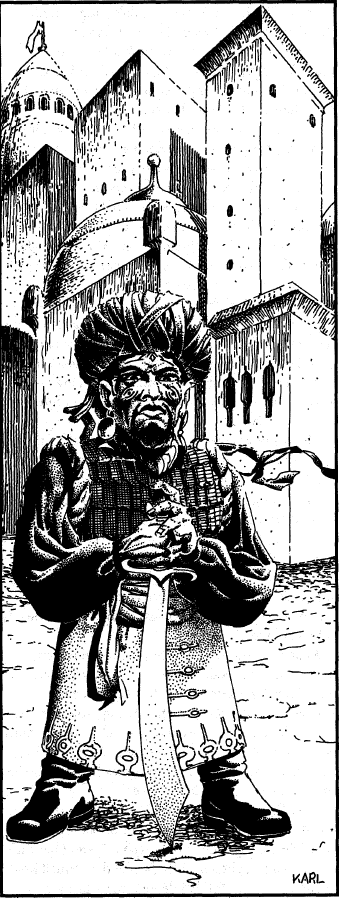
To a foreign observer he may seem like just a dwarf with a sword, but this lone mamluk is but one of many building blocks in the wall of the Caliphate’s army.
Qudra, City of Power: This is the most militarized city in the Land of Fate. Many generations ago a corrupt emir oppressed his populace to the point that the locals rebelled. As he was already on poor terms with the eighth Grand Caliph, it did not take long for the stationed mamluks to join the populace in overthrowing him. In recognition for their deeds, the mamluks were allowed to choose among themselves who shall be emir. This spawned a tradition of Qudra’s mamluk rulers, who traditionally rule for 20 year terms. The book notes that the position used to be for life, but there’s no mention of what caused the change. The emir’s court has representatives of the Caliphate’s different mamluk organizations, and include such icons as General Okin, an elf who worships Zann instead of Vataqatal which sets him apart from his peers. There;s also General Kalin, a human woman with a notable streak of white in her hair much like a legendary mamluk of old. Kalin has trouble cultivating this into a proper reputation on account of her brashness. Admiral Dus is a goblin whose mamluks are in charge of providing safe passage to ships, but the officer is rather slothful in his duties.* The mamluk naval units have a rather poor morale on account of a failed attempt at conquering the Corsair Domains five years ago.
*Dus is also one of the few low-level authority NPCs, being a mere 5th level Mamluk Fighter.
Much of Qudran architecture tends towards practical blocky stone buildings, with a giant chain in the harbor which can be raised to protect from naval invasion and outer walls carved out of granite to protect from landbound threats. Interestingly, much of the populace are civilians who support the elite mamluk units that act as both standing army and city watch. An authorized slave market holds Hill Tribe and northern barbarians along with criminals, and a group of spellcasters oversee the market to ensure that the innocent are not enslaved and that existing slaves are not mistreated (aka no law-abiding Enlightened, no physical torture). Over the past years the mamluks have had more difficulties gaining newer generations of slave-soldiers, so there are plans to rectify this: recruit from voluntary townspeople, or hunt for slaves farther afield.
The local god Vataqatal has a mosque of his own: the Mosque of Blood is painted red with henna, while an Open Mosque which honors the various other Enlightened gods is blue.
Strangely, I couldn’t find an official color for Qudra.
Secrets: General Adun was very boastful of his many military victories, which caused him to be overlooked in favor of a more humble leader while also placing him under the curse of the evil eye. He still bears a grudge for this, and is looking for ways to delegitimize the other generals in an attempt to elevate his own position.
A sha’ir by the title of Mad Asham, once thought lost during a scouting mission in the Haunted Lands, appeared back in the city with a bout of amnesia that cannot be cured even by a genie’s wish. He speaks of a Whispering Doom, although there’s little specific details that can be coaxed out of him as to the specifics of this threat.
Umara, City of Knights: In recent times the unthinkable happened: the Astok clan, one of the Unenlightened Hill Tribes, laid a successful siege against the Free City of Umara. Its Khan, Ubar khel Muhif, took advantage of Umara’s previous failed war with Muluk to depose the ruling caliph and marry his daughter. But instead of burning down the city or leaving, he took over as the new caliph. The local mamluks recognized his legitimacy, and Ubar khel Muhif used his power to help rebuild the city. There is an uneasy peace in Umara, where the former nobles and merchant families are kept in place, while the Astok people are permitted to worship their own ancestor god Botu’Astok as a Common God while the Enlightened mosques are still allowed to attend to their flocks.
The city’s official color is blue, although cobalt and turquoise are just as popular for textiles.
Secrets: There are rumors that the former caliph was exiled instead of executed after Khan Muhif listened to his wife’s pleas for mercy. But the truth is that the old caliph is indeed dead, slain in private by the Khan as a means of ‘keeping the peace’ with his new wife. He may very well send the PCs on a wild goose chase to find a man who no longer lives if it will keep troubling adventurers away from the truth.
Utaqa, City of Free Men: The northernmost city in the Caliphate is 200 miles away from the nearest city of Hafayah, which causes both visitors and inhabitants to feel that Utaqa is in a world of its own. Caliph al-Gandar was installed as a puppet-prince by Qudran mamluks, although he realized that he’d need to delegate much of his power to the citizenry and merchant houses to keep the wheels of government turning. As long as Utaqa maintains an effective border shield of the empire’s north, neither Qudra nor Huzuz have much reason to interfere.
One council member, Chawus al-Rark, helps Corsair Domain pirates smuggle goods in exchange for immunity from their raids; Allena al-Ajami, a foreigner mage, serves as vizier and updates the court on all matters pertaining to barbarian outsiders; and On-Basi al-Garn is a scribe who helps “pretty up” reports on state affairs. He landed in hot water for claiming that Utaqan soldiers secured victory against a raiding party of yak-men. The foul monsters in the World Pillar Mountains heard of this insolence, and sent a warning by summoning a dao genie right into al-Garn’s bedchambers.
Utaqa has a diverse mixture of Enlightened Zakharans and various foreigners, which results in a more pragmatic view on things: most of their priests are Pragmatists, and the city outlawed slavery to make it a safer travel destination for Unenlightened people. Foreign merchants who own slaves have their prisoners temporarily liberated while in town, and must pay their slaves as though they were employees while in town. Given that said merchants still hold all the money, this system can be easily abused. There’s also worry that inspectors from Qudra plan to arrive and judge the city’s ability to serve as the Caliphate’s shield.
The city’s official color is white, representing purity.
Secrets: The yak-men’s agents are upping their ante in Utaqa, both via magic jar-bound bodies of their servants and even showing up themselves in heavy clothes. In the latter case, they disguise their horns as being part of a “horned helmet” and only travel the streets at night.
Chapter 8: Cities of the Pearl
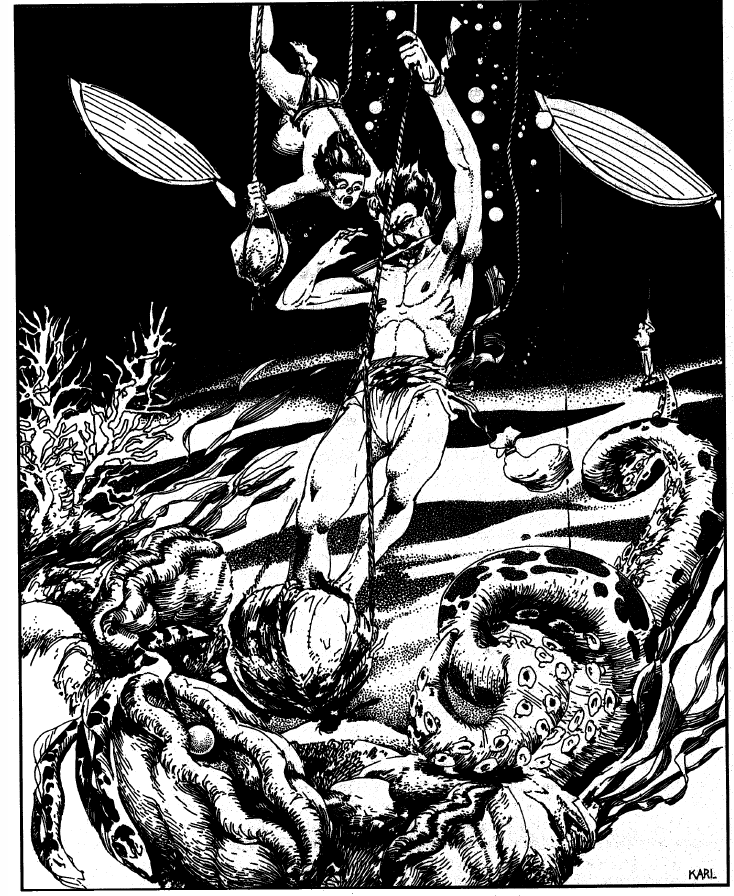
If the previous chapters’ cities were the rough, martial frontier theme, the Cities of the Pearl’s theme would be wealth and trade. Six cities line the western shores of the Golden Gulf, where wares from all over the Land of Fate and beyond are for sale. Some of the richest people live here, but so do the poorest due to a lack of social safety nets and usurious debtor’s prisons. In fact, the Cities of the Pearl rely on slavery less for labor and protection due to this practice, and the rich often hold bread and circus style feasts and celebrations to keep the lower classes from growing too despondent and resentful. The Cities of the Pearl have a regional rivalry with the Pantheist League sitting on the eastern shores, who regard the laissez-faire merchants as decadent ‘peacocks’* who strayed from the Law of the Loregiver.
*An insult in regards to the Pearl Cities’ more colorful array of clothes; only black fabrics are permitted in the Pantheist League.
Ajayib, City of Wonders: This city is famous for its rich coffee, as well as being on the Caliphate’s western border. The al-Suqut Mountains stretch out to the sea, populated by monsters, outcasts, and Unenlightened tribes. The city in fact came to Enlightenment only recently, the current warrior-queen caliph being the second ruler to follow the Law.
Secrets: The nearby mountains and cliffs descend deep into the Underdark, and communities of duergar and drow are hostile to foreigners. The rumors of both races gave rise to tales of an old ruined city whose inhabitants seek revenge on the civilized men who destroyed them long ago. This kind of contradicts the claim that Lotha/Lolth is a dead god if the drow are indeed still alive.
Gana, City of Riches: One of the two cities which gave the region its name, Gana’s economy revolves around the pearl-diving industry. Some of the more well-to-do captains of diving ships utilize magic to allow divers to breath underwater for long periods. During the months where their primary luxuries are not in season, the people harvest frankincense from trees. The reigning Sultan, Yusef the Just, is not fond of concentrating power in any one set of hands for too long, and as such regularly rotates his court with many advisors with a high turnover rate. What’s notable is that the city’s chief judge can be ‘rented’ for a short term and readily dismissed if they prove too unpopular; perhaps not unexpectedly the current judge doesn’t always seek the heart of the matter in cases even if she is aware of it.
The city holds a 3 day Festival of the Pearl, a time of riotous feasts and celebrations. Fireworks, known as skyrockets, are particularly loved for their stunning explosions at night. The sultan presents a Great Task of the Pearl, where between now and the next pearl season people bring the most wondrous things they can find and present to a group of judges. The contestants give their items to the Sultan for ownership regardless of the results (such is the risk of partaking), but the winner gains land, monetary reward, magic items, or some other great favor from the city.
Secrets: There are rumors that the sea mage, Al’ia bint Hazir, secretly bore the Sultan’s children. They are true, and four of them are being raised in seclusion in a monastery. They all have mixed feelings on their current predicament, and there are three scrolls with proof of their lineage. One is in Al’ia’s possession, a second in the library of the Grand Caliph, and a third was sent to Qudra but whose messenger never made it for unknown reasons. The Sultan has borne several children from concubines, although he does not recognize them as heirs, which is actually a large faux pas in Zakharan culture.
I’m a bit unsure as to why the Sultan is going to great lengths to hide his children. There’s no indication of an uneasy political situation or assassination attempts on previous heirs; if it’s for ideological reasons it seems a bit far-fetched as he could theoretically pass a law to impose term limits or something similar to the temporary judges. And Al’ia does not sound like she’s a noblewoman, so I don’t know why he’s hiding only their children and not that of his concubine’s as well.
Many divers have started disappearing as of late. People figure that the mysterious monster plaguing the city of Jumlat is responsible, although some believe this tale to be a ruse by a rival city who is in fact killing the pearl-divers. The Sultan promised 50,000 gold dinars* as a reward to whoever can unearth the truth.
*Gold and silver pieces in the Land of Fate are based on real-world currency used in the ancient Arab world. Dinars are gold, dirhams are silver, and copper pieces are known as bits.
[
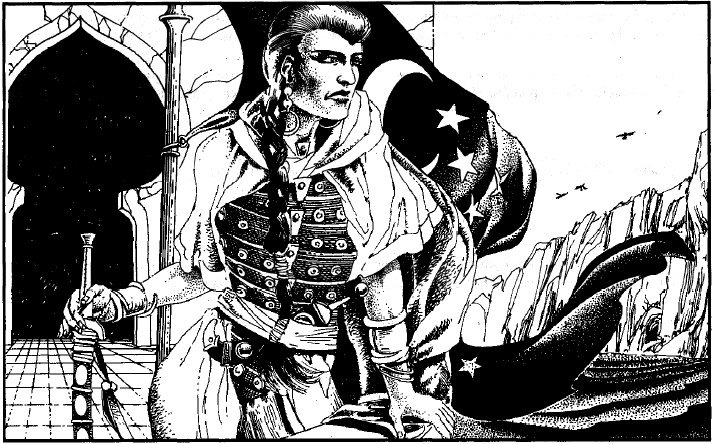
Jumlat, City of Multitudes: The other “true pearl city,” Jumlat has a rivalry with Gana. One it is winning, for it has a more lucrative pearl harvest. Its ruler Kara al-Zalim is known as the Fierce Sword of the Sea, and led many fleets against Gana’s own forces in raids before he was granted the throne (a departure from the normal ancestral heir). His court has two rather unsavory individuals. The first is Agat amir-Doth, an elven sorcerer who has a fetish for human women. He sets plans into motion to cut off particular women from their friends and family until they have little choice but to become his concubine out of economic necessity. The other figure is Ragi al-Makruh, a spoiled heir to a merchant empire whose assets are the only thing that make up for his lack of brains and charm. This is in spite of the fact that he’s a 19th-level Thief with the Merchant-Rogue class-kit.
The past three years have been tough on pearl-divers, with many ships ending up destroyed or lost at sea. Jumlat blamed Gana for this, but before things escalated to war a diver missing his legs washed up on a beach, speaking of a tentacled shark-like creature who intelligently hunted and destroyed the rest of his crew. The city’s sultan offered a reward of 100,000 gold dinars to whoever can find and kill the creature. Additionally, a mysterious avenger of the city’s poor known as Zulmat (“the Darkness”) has been attacking the cruel and corrupt figures in power.
Secrets: Zulmat is a 14 year old girl inflicted with weretiger lycanthropy, whose older sister became the latest target of Agat amir-Doth’s twisted affections. Zulmat is recruiting a small but growing gathering of supporters among the populace, and has no knowledge of her altered form which acts on her desires for vengeful justice.
The tentacle-shark killing divers is in fact an aboleth who abducts sailors to enslave and mind-control them into expanding underwater caverns. There are either four such aboleths, who will avenge their kin if one is slain, or there is but one who will return as a ghost if killed.
Sikak, City of Coins: Sikak is more known for fishing, but I suppose City of Fish is not as catchy a title. Sultan Magar al-Azim’s gnomish family is known for working directly alongside fishermen, which makes him seem more of a “man of the people” and earns the commoner’s trust and respect. His concubines and female relatives are noted as being the most beautiful in all Zakhara, and he has a large family of children, cousins, and siblings who fill important roles in the city’s bureaucracy. Its artesian wells have begun to fail, and Sikak employed dao and marid genies to help repair them.
Secrets: Two things are on the minds of Sikak’s inhabitants. A holy slayer of the Grey Fire attempted to assassinate the Sultan in public but was killed by an ogre bodyguard. Two possible options are provided: one is that the Sultan is withholding tax tribute from the Grand Caliph, and one of his siblings arranged for the assassination to prevent a new ruler being appointed by Huzuz who will have no ties to the gnomish family. Another possibility is that the Grey Fire feels that the Sultan is not holding as good an example to their patron deity Najm, and feel that his heir would be a better fit.
The other major event is the discovery of a recent shipwreck off the coast of unknown age and origin. The shipwreck may be the result of a tragic calamity of fleets crashing into each other during a monsoon, or a downed experimental gnomish skyship holding treasure and monsters.
Tajar, City of Trade: Whereas the other Cities of the Pearl have some kind of specialized local resource, Tajar is a jack-of-all-trades in its wares. In spite of such abundance competition is strict, and the merchants here look down upon haggling. Musicians can be found on all corners, often going for volume over talent in hopes of being noticed. Almost every business is in need of hired hands, so unemployment is low. The numerous artesian wells mean that only the poorest have to rely upon the nearby al-Adib River for their drinking water.
The current ruler is Sheikh Ali al-Hadd, whose father was a tyrant that sought to enslave the nearby desert tribes. During a local rebellion the Grand Caliph sent investigators, not reinforcements, who discovered the ruler’s guilt. The son has proven to be a fairer leader, although his only son Afzal is spoiled and egotistical to the consternation of Ali and the court. His daughter Sheera is more rational and serves as a sha’ir in charge of all things genie-related in the city. Adding to this political assortment is a mysterious traveling bard by the name of Dulcet Riqqiyah. She quickly befriended Sheera, but is still rather guarded about her background. Dulcet even went so far to wear magical items that counter divination spells at all times.
Secrets: Dulcet is actually the granddaughter of the original tyrant sultan, and seeks to destroy the city from within. The dao that guards Prince Azfal is actually an assassin in waiting, and the only thing delaying this order is finding the perfect target to pin the blame. An alternative idea is that Dulcet is an adventuring bard unknowing of her true heritage, but a new sorcerer in the court hoping to kill the Prince hopes to pin the blame on her as the assassin.
I do feel that a secretive bard with anti-divination measures would be far too suspicious for a noble to befriend. Unless of course she had some means of leverage or favors that are too good to refuse. It’s a bit of a weak hook In my opinion.
A notable zookeeper known as Suelasta the Magnificent has come into town with a variety of fantastical creatures. The restraints in place are poor, so when they escape he’ll need to find suitable adventurers to track down the beasts and return them to him alive.
Thoughts So Far: Both chapters paint evocative, distinct cities overflowing with adventure. I like how the Cities of the North have very different themes, with different official colors providing obvious visual cues. It’s a great place for PCs to adventure, be it dungeon delves in Qadib or sailing the high seas in the Corsair Domains. Umara and Utaqa’s position as having a heavy foreigner/barbarian presence provides for good means of integrating PCs from lands beyond Zakhara.
The Cities of the Pearl are not as varied in my opinion, but they still have a good mixture of adventure hooks. I am quite fond of the unknowing weretiger vigilante and the “multiple choice” hooks for plots. I notice that Zakhara’s high-magic nature persists beyond just the heart of Zakhara’s empire; magic is used in commerce and summoned genies are treated as valued assets for personal guards and public works projects. I feel that it really brings out the wondrousness of Abeir-Toril’s ‘high magic’ while not being as arbitrary and extreme as the default Forgotten Realms.
Join us next time as we cover the final two regions in Zakhara: the conservative League of the Pantheon and the lands of the Ruined Kingdoms!
Chapter 9: Cities of the Pantheon
Original SA post
Chapter 9: Cities of the Pantheon
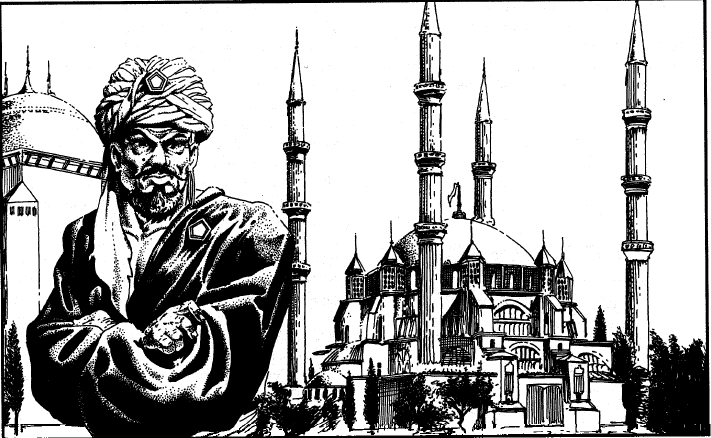
These six cities are spread out on the eastern shores of the Golden Gulf. Its citizens are known as Pantheists for their reigning ideology where they recognize only five deities as being truly Enlightened. The worship of other deities within their borders is illegal, and their practice of enslaving otherwise Enlightened Caliphate citizens for pushing the envelope does not endear them to their neighbors. They still pledge loyalty to the Grand Caliph, although there are some factions who feel that the administration in Huzuz is becoming corrupted by blasphemers.
Church and state are highly intertwined, and pretty much every ruler or government official is a Moralist priest of some sort. Rulers of the cities have the title of Revered Father, or in one case Revered Mother, regardless of whether their normal title would be an emir, caliph, or likewise. Their conservative beliefs regarding suspicion of the “latecomer deities” extends to a skepticism of social change in general. Which so far works in terms of political stability: even the poorest citizens are guaranteed subsidized housing, healing, and food as part of a religious emphasis on charity, and the Pantheist League cities are much less inclined to war upon each other. I’tiraf is their unofficial capital, and other cities send representatives there to discuss issues in the League Conclave. The government is quite centralized, where bureaucracies can affect multiple settlements in determining a universal set of prices, redistribution of food in regions with grain shortages, and so forth. The League makes use of a universal army known as the Sword of the True Goods, whose members are made to serve in other Pantheist cities to encourage community bonds beyond their hometowns.
Fahhas, City of Searching: Fahhas may have fertile farmland and rivers, but its people are stand-offish and a bit depressed in no small part due to their ruling caliph, Amel al-Yuhami. The death of his former vizier and dear friend changed him, causing him to view the worst in others and becoming crueler in his dispensation of laws and punishments. Torture and executions are becoming more common than temporary slavery and exile. He banished his former court in favor of bureaucrats he can more easily control as well as kicking out all of his female family members by disbanding the palace harim. His easy-to-offend nature causes the overworked chief judge speed through trials if it means avoiding the caliph’s wrath.
Secrets: The former vizier, Jamali al-Muhib, did indeed die. But she is not truly dead, but a disembodied head of a lich due to a botched ritual which only partially completed the undead transformation. The caliph could not bring himself to destroy her, and imprisoned Jamali in a room lined with lead plates inscribed with holy scripture. Amel still visits her weekly, but her evil nature means that she poisons the caliph’s mind and makes him see threats where there are none.
Hilm, City of Kindness: Hilm is the most tolerant of the Pantheist cities, although still conservative by Zakharan standards. The reigning caliph and people of the city still believe in the superiority of their teachings, but seek a ‘lead by example’ method of evangelism where good works and ensuring Hilm’s prosperity will win over more converts than fire and brimstone threats. This is in part due to the fact that it is a popular land route for pilgrims traveling to Huzuz, many of whom are not Pantheists (although even then they know better than to preach their variant beliefs too publically). The streets are clean, crime in general is rare beyond out-of-town troublemakers, and every citizen capable of work is encouraged to devote time to farming or renovation of buildings to ensure that their neighbors have a good quality of life.
Secrets: Much like Wasat in the Cities of the Heart chapter, Hilm is intended to be a subdued Shire-like environment where adventure plots revolve around external threats that threaten the peace. Two such sample threats include the kidnapping of the caliph’s daughter which will drive the inhabitants into a vengeful frenzy against whoever they believe is responsible, and being upriver from Talib makes it susceptible to said city’s wererat plague.
Hudid, City of Humility: Hudid’s location as a port touching the shores of the southern Crowded Sea means that it gains a lot of exotic trade goods from the region’s islands and archipelagos. As a result the laws regarding Unenlightened behavior are slightly relaxed for first-time offenders. It is also home to the greatest university of the Land of Fate, teaching a variety of secular topics as well as religious ones including non-moralist philosophies! It is peculiar for the assignment of a female Caliph,* Sajah al-Munsif, who at first had many critics on account of her gender but eventually gained universal legitimacy when said critics' proclamations of societal collapse failed to bear fruit. She bore twin daughters, one of whom seeks to climb the ranks of the local church, while the other left the family upon adulthood for parts and fates unknown.
*I believe the proper grammatical term would be ‘Calipha.’
Most problems in the city are minor bouts of sectarian fighting in the docks and university between moralists and non-moralists, but a more prominent dilemma are refugees fleeing from the city of Mahabba due to violence involving worshipers of Bala. The Mahabban government believes that Hudid is giving covert support to this banned faith by accepting refugees, and their suspicions are reinforced by Sajah’s refusal so far to investigate the matter further.
Secrets: The Black Library is an open secret in the university, containing books that are too valuable to destroy yet containing heretical teachings: subject matter includes many adventure hook material, such as secret rituals of the Brotherhood of the True Flame and penned history of the Ruined Kingdoms. The Balanite worshipers are active, and their leader is romancing the caliph’s priestess daughter who is aware of her lover’s faith. The caliph’s other daughter became a prosperous merchant in the Pearl Cities; she despises the Pantheist League and may return to her hometown one day to cause chaos.
I’tiraf, City of Confessions: The League Conclave serves as the governing body of the Pantheists, and its location in I’tiraf makes the city extremely important politically speaking. The citizens' egos are similarly swelled by this, believing that Zakharans outside the League are no better than Unenlightened barbarians. Some even claim that no evil or heretical people live here. But when they come within its walls, they are quickly found and punished for their crimes, or so they claim. Its emir, Most Revered Father Rimaq al-Nimar, is the most powerful person in the League and rarely appears in public. Government officials refuse to let non-moralists in the Conclave building or within the emir’s presence, and heavy taxes are levied upon merchant caravans and vessels who cannot prove a moralist faith. Non-moralist merchants get around this by hiring ‘captains of convenience’ to conduct business and trade on their behalf.
Xenophobia has been growing in I’tiraf as of late. Every so often a rumor spreads that warships from the Pearl Cities, Afyal, or some Unenlightened place spread. Panic escalates to the point that hate crimes against foreigners increase, and the city watch and navy use this time to increase their forces and funding which persists long after the riots subside.
Secrets: The Revered Father is actually an illegitimate child. Rimaq’s true father is but a humble baker, for his mother’s husband was unable to conceive children and thus turned to other methods to ensure the line continues. There are two possible means of resolution provided: the Revered Father is dismayed but eventually comes to terms with this, stepping down and passing leadership to a worthier candidate* before becoming a wandering pilgrim. Or Rimaq steadfastly denies the charge, and in turn causes an eventual power struggle and maybe even a civil war within the League or the hometown of his biological father.
*who may not prove to be a worthier choice after all.
Finally, the ambassador from Talab is a wererat, who in truth only acts for the furtherance of his kind, his official Moralist duties are but a cover identity.
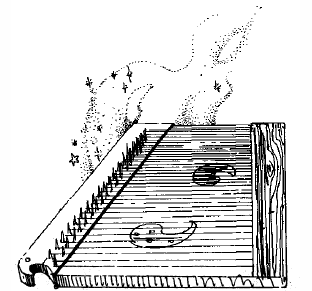
Mahabba, City of Charity:Another port city, Mahabba is much less tolerant than Hilm or Hudid in no small part to violent religious conflicts with the followers of Bala of the Tidings. Although most in public preach adherence to moralist teachings, Mahabba is more of an occupied city whose soldiers fear that Bala’s cultists may lurk within any home, waiting to strike. The caliph and his court are similarly affected: its Revered Father is a half-elf faris* who only trusts advisors that have personally seen battle firsthand, while one of his viziers is an ex-wife who mutually divorced upon realization that they were more devoted to their jobs. The chief judge, Othmar bin Jaqal, is also in charge of spies, and while he has suspected ties to the Brotherhood of the True Flame most in government are more concerned about Bala’s followers at the moment to act on this.
*Devoutly religious Fighter class kit.
The city’s major thoroughfares are lined with checkpoints, and Othmar’s spies retain a Stasi-like influence as informants and agents. Curfews occur immediately as night falls, and music in general has been all but banned for fear that Bala’s followers can enact foul magic through song, instrument, and poetry. Although Bala’s followers have lived secretive lives for the past 500 years, they conduct rebellions on and off again every few generations; this spate of martial law is a more recent one, starting two years ago in response to the assassination of Mahabba’s previous ruler seven years ago. I must admit, a half-decade of inaction seems rather slow to me.
Secrets: Bala’s worshipers have an elaborate series of gestures and code words to communicate with each other. Their own violence has increased in spite of martial law, to the point that even civilians suspected of aiding the government (such as foreign traders) have been attacked and killed. The old temple of Bala has been long since destroyed and buried, but there are some underground chambers still intact with powerful relics.
Talab, City of Questing: Bordering the Ruined Kingdoms and Haunted Lands, Talab is a common first stop for adventurers seeking to plunder the secrets of said regions. Its caliph, Kia al-Sadid, prefers the more down-to-earth title “Humble Servant of the Enlightened Gods” rather than the Revered Father moniker. This is because he is serving an interim leader on account of his predecessor’s assassination at the hands of the Storm That Which Destroys, a holy slayer fellowship which acts as the “shadow army” of the Pantheist League. Kia has a light hand on trade, but when justice is demanded his response is swift and fierce.* His primary court assistants are a priestess scribe and librarian, and a barbarian convert to Pantheism who acts as an emissary to his own kind.
*or so the book claims. See below.
Talab is far inland in an arid region, its populace relying upon wells connecting to underground streams in the nearby mountains. They’re guarded by a mamluk society known as the Parched. Talab is also home to a thriving slave trade; Kia’s predecessor was more hands on in regards to prosecuting illegal slavery (enslaving the Enlightened), which some believe may have been why he was slain in the first place. Now the authorities look the other way...which seems a bit contradictory in regards to the caliph’s swift justice above.
Many tribes from the Ruined Kingdoms pass through here, although the city-dwellers are suspicious of them as well as the desert tribes of the Haunted Lands. The local government is highly concerned about diseases and the health of its citizenry, and commanded the Parched to conduct renovation and upkeep of the wells while also charging slave-traders with increased regulations as to the health of their slaves.
Secrets: The seeming concerns of Talab’s caliph are but an act. He as well as his entire court and the Parched mamluks have been infected with lycanthropy of the wererat strain. Kia’s eventual goal is to infect the rest of the city via poisoning their water supply, which will also affect Hilm. As their numbers grow, Kia hopes to become leader of a changed Pantheon as a sort of ‘wererat king.’
Hanya al-Mufih, the barbarian ambassador, may have one of two origins: the one offered in the Adventurer’s Guide as an Unenlightened-turn-missionary, or being a secret member of the Storm Which Destroys. He helped assassinate the previous caliph, manipulated in part by Kia.
Chapter 10: Cities of the Ancients
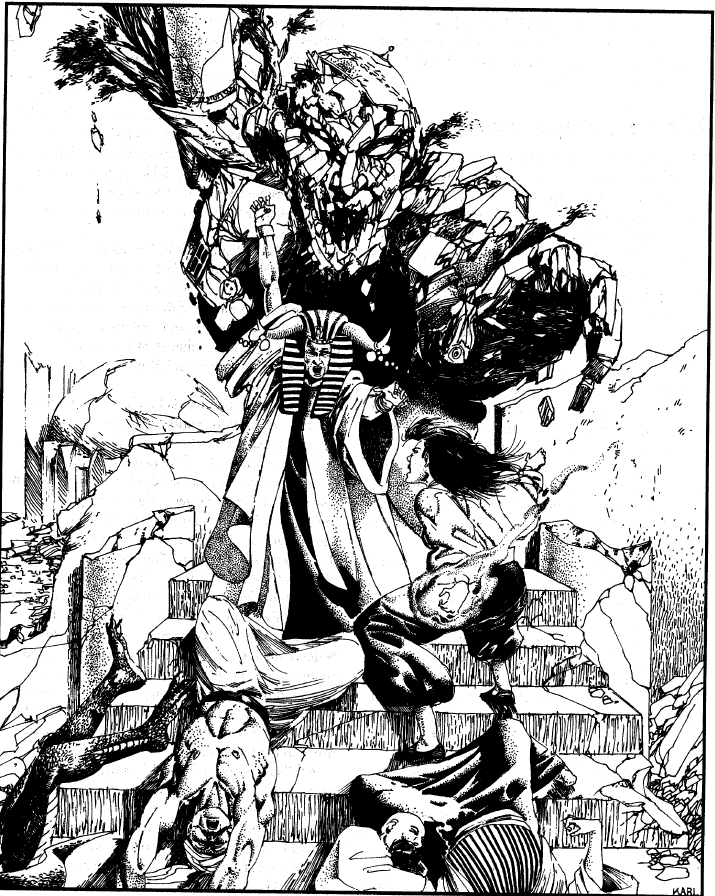
The easternmost lands of the Zakharan peninsula are perhaps the most geographically distinct. Most of the land is covered in sweltering rainforests, with several large tropical island chains off the southeast coast. In times long past various Unenlightened empires ruled, some even as far as the Haunted Lands and modern-day Pantheist territory, but only the kingdoms of Nog and Kadar are known by name in modern times. A third civilization once ruled over the island of Afyal, and the number of kingdoms beyond is hotly debated over by historians. Nobody knows what entailed the decline of the Ruined Kingdoms, but evidence of their existence is demonstrated by their decaying structures and temples.
The people of the Ruined Kingdoms were relatively isolated from the rest of Zakhara, and as such were the ones that came to Enlightenment the latest. Those from elsewhere in the Caliphate can be prejudiced in regards to this, viewing them as still being nostalgic for their supposed savage ways and gods. The Ruined Kingdoms’ inhabitants, for their part, believe that their ancestors still live beneath the ground and may one day come back to life, even if they’re more comfortable with the Enlightened faiths. Slavery in general is more common here, and the governments of Halwa and Dihliz aren’t overly concerned if they end up enslaving fellow Enlightened or not. Its leaders take the title of Khedive, a local term for rulers.
Dihliz, the GatewayCity: Located on a plateau, Dihliz is a primary trade city for those seeking to travel to and from the rest of the Ruined Kingdoms. Its government is highly involved in trade via the Ministry of Secrets which catalogs various dungeons, ruins, and similar places in the region while also granting adventuring parties claim rights to areas. Its archives are less than useful, as scrolls are frequently misfiled or stolen. The Ministry of Riches imposes a small tax on all treasure extracted from said places, and since most such goods are smuggled anyway, the Ministry devotes most of its efforts to regulating dangerous magical items.
Most of Dihliz’s buildings are stone foundations said to be fashioned from the bricks of a pre-Enlightenment temple. This bears a hint of truth, for most buildings contain anti-divination magic which blocks most scrying and “Detect Evil/Magic/etc” spells. It also has an interesting relationship with the island city of Afyal: 100 years ago Dihliz was formed by said city to regulate the adventuring and treasury industry. Although theoretically independent, its local ruler is assigned by the Grand Caliph at the recommendation of Afyal’s padishah.
Secrets: The pre-Enlightenment inhabitants of the region created a particularly powerful earth monolith to serve as a river guardian; during a war in the last days of Nog, the entity was destroyed, her body mixing with the dust of the region. The monolith’s magical ambience is responsible for the anti-divination stonework.
The Ministry of Secrets are no fools; evidence of truly valuable and dangerous sites are secreted away in a well-guarded library, its finders bribed or threatened into silence. The public archives are but a front.
Kadarasto, City Most Sinister: Located 100 miles inland on a river from Dihliz, Kadarasto has unique ancient architecture which is angular, windowless, and has a preponderance for five-sided rooms. It is believed to be built on the ruins of Kadar’s capital, and has a negative reputation. Its ruler, Khedive Aman al-Qasi abu Nari, is an amoral politician whose “mouth intones the prayers but whose heart is as black as ebony.” Other rumors include that his mother was a priestess of Shajar (local pre-Enlightenment god), and his father a member of the Brotherhood of the True Flame. He is popular among the common folk on account of being of local origin rather than a foreign appointment, and also because he and his son’s legions guard the local ruins from tomb-robbers hailing from Afyal and Dihliz. The city’s rich hate him but tolerate him as a necessary evil; the city’s economy profits off of the ruin-delving trade.
As you may have guessed, there are several pre-Enlightenment cults still worshiped in secret, and their followers use underground catacombs to conduct their rites.
Secrets: The Khedive’s evil is not supernatural in origin, nor do his parents have ties to any secret societies. He is a selfish person who realizes that a careful balance of power between the rich and poor, Enlightened and Unenlightened, is preferable than chaos. His son, on the other hand, is more ideological in regards to preserving Kadarasto’s cultural heritage and has made contacts among the cults, the Brotherhood of the True Flame, and even the Storm Which Destroys in hopes of using them to harm adventuring interlopers.
Finally, Cholk min Kado is a rich merchant who poses as a simple carpet-dealer but runs a criminal empire of antiquities and magical items.
Medina al-Afyal: “Medina” is the Arab word for “city,” and I’m unsure as to why this one’s entry differs from the standard format of “X, City of X.” The island itself is commonly known as Afyal, or the “Island of the Elephant,”* while its major city Medina al-Afyal, or “City of the Elephant.”* Afyal is a rich land of abundant natural resources, specializing in local hardwood not found elsewhere in Zakhara along with mines of precious metals. The ruling House of Alon has a close heritage to the family of the Grand Caliph, something in which the city takes pride. Sadly, its current ruler, Alad bin Alaq bin Alonka of Alon, is certifiably insane and delusional. The man is known for rather illogical decisions, ranging from appointing people to government posts based on a pleasing physique, recognizing all 22 of his at-present children as being equally worthy of simultaneously ruling the city upon his death,** and ordering new buildings commissioned then destroyed in a week, and then rebuilt again with no rhyme or reason. The padishah still acts on good intentions, his policies wrought of logic that makes sense only to him rather than for selfish or petty reasons. He is fond of traveling through the city streets on a magically floating palanquin, accompanied by pots shooting out silver and copper pieces into excited crowds.
*According to Google Translate, the Arabic word for elephant is الفيل, or “alfil.” Which seems close to Afyal, so this part may also be grammatically correct.
**He initially had the choice for an eldest heir, but that one went missing on a voyage.
The Island of Afyal is full of humid hills and jungles, with various small villages of woodcrafters and lumberjacks connected by roads. The capital city’s buildings are made of marble and hardwood, giving an aesthetically pleasing and unique look. The mosque serves as the largest center for Selan’s worshipers in the Land of Fate, and the padishah’s palace combines mundane and magical means of construction. A series of linked buildings and towers are regularly reshaped by dao genies at intervals.
Afyal is also notable for a caste system, where one’s economic and occupational role in life is believed inevitably fixed by Fate. A person may never rise above one’s station, and the lower classes are expected to defer to their betters in all things regardless of merit or circumstances. Additionally, the island’s elephants are unusually intelligent and docile, easily domesticated for all manner of tasks. Killing an elephant is a crime punishable by death.
Secrets: The padishah is insane, so the government and economy functions day to day by merchant houses. The Crown Prince, Alakbar, disappeared on a voyage into the Crowded Sea four years ago. His fate is left to the DM, but if he were to return then the Padishah would recognize him and not his 22 other children as the next-in-line.
Various elephant statues to the Lost One are being rediscovered around the island. In order to better hide from the Enlightened faiths, the god dissipated his essence into the islands’ elephants, which is why such animals are more intelligent than their kind elsewhere. When 10 or more of them gather they are capable of casting Charm spells of increasing magnitude based on their present number. The elephants only use such spells to encourage people to carve more idols of the Lost One. Beyond this, the god does not encourage the elephants to violent behavior and seems rather peaceful.

Rog’osto, City of Spires: This metropolis’ title comes from its huge metal spires with rounded tops, whose visual similarity to mushrooms also gave it the alternate title “City of Fungus.” Such towers are not found anywhere else in the Ruined Kingdoms or Land of Fate proper, and their interiors have been renovated to serve as living space for modern-day inhabitants. The towers’ construction points to evidence of a civilization neither human nor demi-human, and 3 of the 25 towers still intact have been claimed by the ruling khedive as a palace. Considered the most magical city in the Land of Fate,* the towers’ legacy attracts spellcasters of all kinds who use them as research labs and private living spaces. The majority of inhabitants live in white-washed mud-brick houses surrounding the towers’ bases, and some of the towers’ foundations have been broken off to form into a rather strong steel alloy that rusts less and melts at a lower temperature.
*Although Huzuz and Qadib are close seconds.
Rog’osto’s ruler, Khedive Samia al-Sa’id, is a powerful sha’ir whose court is made up of various factions acting as delegates for spellcasters of a certain tradition or more mundane occupations. Some of the more interesting figures include a flame mage who is open about his membership in the Brotherhood of the True Flame, but claims that most of its negative reputation is due to a few bad apples;* a Pantheist League ambassador who only stays in Rog’osto so she can pay adventurers to smuggle magical items out of the Ruined Kingdoms so they don’t end up in the hands of “Unenlightened mages;” and an ambassador from Afyal who will handsomely reward any adventurers who can unearth the truth about the race that built the towers.
*Not true.
Secrets: Rog’osto’s towers were built by locathah back when much of the land in the area was underwater. They warred against an air-breathing race who summoned a great elemental force to raise their civilization past the water level, thereby drowning all those who could not escape in time. The locathah survivors retreated to the deep ocean.
Thoughts So Far: I like both of these chapters, although with a preference towards the Ruined Kingdoms over the League of the Pantheon. One thing that has been bugging me about the moralists is the Leagues’ seeming harmony; the class description of a Moralist Priest in Arabian Adventures points to holding a single deity as superior and more prone to fighting devotees of other gods and faiths. While this makes sense from a Pantheon/non-Pantheon perspective, the League is rather united and tolerant as it concerns their five favored gods. I’d expect the moralist cities of the League to be more prone to conflict than ones in other regions, but that would erase their rising power as a unified bloc.
Another thing that strikes me as odd is of the Storm Which Destroys being more approving of a deregulated slave trade in Talab. Although we’ll cover them in Fortunes & Fates, their duties are to advance the cause of the Pantheon and settle internal disputes, and are often regarded as radical even by most of the Leagues’ members. I presume that most of the Enlightened being enslaved may be non-Pantheists, which would make sense, but the previous rulers’ crackdown on the trade to be replaced with a more crooked ruler intones that Pantheist followers were targeted as well. This is an area which it would help to more closely explain.
The Balinite and wererat conspiracies in Mahabba and Talab serve as good sources of conflict in the otherwise safe and clean League, and I do like how the other regions (such as the Pearl Cities and Ruined Kingdoms) touch upon their influence beyond their chapter proper. It serves to make the League feel like a veritable geo-political power unmatched elsewhere in the Caliphate.
Going on to the Ruined Kingdoms, I love this chapter for several reasons: first off is that it’s the most friendly to the typical Dungeons & Dragons experience. The cities’ economies are moved in large part by the dungeon-delving trade, and the mysteries of prior civilizations give fodder for the DM to come up with concepts and ruins that may be strange elsewhere in Zakhara. Al-Afyal’s intelligent elephants, Rog’osto’s alien spires, and Dihliz’s anti-divination properties help reinforce this and show that there are secret legacies far older than mortal civilization. I also like how Kadarasto deconstructs the ethical problems of dungeon-delving, with a populace that quite justifiably feels that adventurers are taking ancestral legacies far from home for the benefit of a few rich buyers.
Join us next time as we cover the Appendices of the Adventurer’s Guide and individual handouts!
Adventurer’s Guide Appendices & Handouts
Original SA post
Adventurer’s Guide Appendices & Handouts
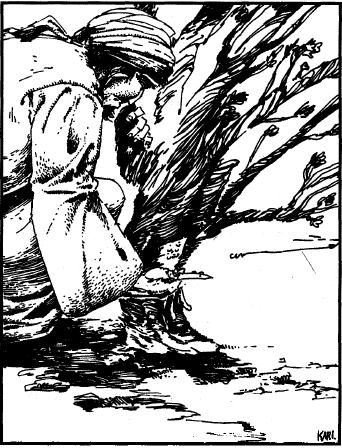
Technically speaking we still have 2 sourcebooks in this boxed set to do, but given the relative briefness of the Appendices in the Adventurer’s Guide I’m covering them as well as the individual handouts.
Appendix A: Legends and Tales of Zakhara
This is an anthology of five short stories spanning ten pages. Due to their briefness I’m going to quickly summarize them, and how they relate to the setting’s history and how things came to be in modern times.
The first tale, the Maiden of Beauty, speaks of pre-Enlightenment times. The woman who would become known as the Loregiver was born with amazing beauty in a world where humanity lived in isolated villages among the coasts. The gods and genies were the true masters of the world, foolish and cruel beings who warred upon each other over territory. When they noticed the Loregiver beauty they sailed to the city in which she lived, and fought among each other for the right to wed her. The individual genie lords and gods threatened her people should they not give her over as a bride, putting the populace in an unwinnable situation. The Loregiver despaired and fled into the far jungles, even going so far as to attempt suicide, yet the very elements conspired to keep her alive. Fate visited her in the form of a mortal lady. Together, they came up with a plan. The Loregiver, disguised as an old man, revisited the city, with Fate using her powers behind the scenes to make her appear more than a mere mortal. And so the Loregiver tricked the gods and genies into an unwinnable contest to see who can find the object of their affections first. They failed, never thinking the ‘old man’ to be anyone other than what they appeared to be, and in exchange she extracted an oath from them to leave the mortal world. Kor, along with Najm and Hajama, chose among their own mortals worthy to act in their stead, becoming the first Enlightened clerics.
The gods never retaliated upon learning of this deception, unwilling to admit they were deceived by a mortal (and clerics know better than to press the issue should they manage to speak with said gods). Fate remained with the Loregiver until her death, and so the Loregiver was inspired to make a series of scrolls which would become known as the Law before burying them beneath her house.
The second tale, the Boy and the Genies, tells of how a miserly merchant feared for his wealth getting inherited by another upon his death. His cousin would be the primary inheritor, so he hired a bandit to kidnap him and leave him in the desert to die. Through the luck of Fate, the youth managed to find a magic sword from the skeleton of an elven warrior and a cave with drinking water. The cave was also home to a jealous ghul guarding a huge ruby; presuming the youth was a thief, she attacked him, but he blinded her by slicing her eyes with the sword and took the ruby. Sadly the ruby was too large to fit through the narrow crevice, so he cut it in two and rolled one half over to trip the blind ghul.
Fleeing back to his home city, he came upon a procession of genies whose lords were gathering in hopes of winning over the Loregiver’s hand in marriage. Unable to avoid their attention he prostrated at their feet, and from them he learned that the ruby was not unlike a great treasure of the dao but later claimed by other genie clans in various wars. The youth came up with a compromise, that the genie lords would hold the ruby in their palaces for three turnings each of the moon before passing it onto another. This is why there are four seasons lasting three months each, tied to the various four elements (winter the wettest, spring the nicest breezes, etc). In thanks for this, each of the genie clans gave to him a wife when he came of age, and he learned magic from them and became the first sha’ir. He asked his wives to use their powers to track down the bandit and his employer, and also offered inquiring mortals who sought to learn about the magical art of the genies. When his uncle was discovered, he gleefully admitted to his crimes. The youth’s efreeti wife beheaded him and turned his body to ashes, where they scattered upon the winds.
The third tale, the City of Peace, tells of how the Haunted Lands came to be such a desolate place and what became of its prior civilizations. It was once a lush and verdant region, but the people living there were vengeful and warlike. The sultan of a local city despaired of these forever wars and consulted his advisors for an end. They told him of a fabled realm known as the City of Peace, whose prized mystic held the answer to the region’s woes. He led a caravan in search of it, and eventually found the mystic… in a now-ruined oasis burned by raiders. His heart filled with rage, he vowed to bring the wrongdoers to justice. A young boy, the sole survivor, had the powers of a mystic and offered to lead him to the City of Peace alone. The sultan accepted, where he was led to a city inhabited by a beautiful woman that was Fate in disguise. She asked the sultan what he sought most, and he answered that he sought to find peace in the land but also gain vengeance against those who hurt his people and the clan of the mystic.
Needless to say, he got his wish. After going through a Rip Van Winkle style time travel slumber, he awoke to find the City of Peace in ruins...and it was in fact his own city. The warring clans were scattered to the far corners of Zakhara until further generations forgot their grudges. Those who did anything to harm the sultan’s people were killed to the very last. The region was now an inhospitable desert, containing hardly anything worth fighting over.
The fourth tale, the Voice of History, is by far the shortest in that it’s mostly a brief outline of Zakhara’s history, as told by a priest of that land addressing the people of Halruaa, a magocracy on the continent of Faerûn. The Halruaans have a hard time believing the more fanciful-sounding tales in spite of living in a city that’s high-magic even by Forgotten Realms standards. The Zakharan replies that their desire for the unvarnished truth is like “boiling the flesh off a duck:” you get to the bare bones, but is unpleasant for the duck. He points to the existence of the sha’ir’s pact with genies, the rotting foundations of the Ruined Kingdoms, and the binding influence of the Law uniting an entire continent as truth to the seeming extraordinary claims of bardic tales.
The final tale, the Dragon and the Genies, explains why dragons are nearly nonexistent in the Land of Fate. Somewhere in the unenlightened North, a clan of dragons destroyed most of their food sources as a result of their destructive raids. They sought to find new fertile lands, and the mightiest red dragon among them scouted south. The dragon came upon Zakhara. Hungry from his journey, he attempted to attack seemingly-normal human peasants for sustenance three separate times. In each result he was repelled by powerful magic from said peasants. Fearing such a land whose mere humans held such power, he came upon a young boy and approached him with fearful humility. Through this he learned that the three other mortals were the boy’s family, and that they had shown him mercy by not using their powers to kill him and instead merely frighten him into fleeing. He was “unenlightened and didn’t know any better,” after all. When asked if they were exceptional individuals for their land, the boy claimed that most were much more powerful. The dragon decided that Zakhara was more trouble than it’s worth and flew back north to warn the rest of his kind. In reality the boy was a genie, but the dragon did not know of this nor did he figure to ask the origin of said powers.
Appendix B: Languages
This discusses the major languages of the Land of Fate. Midani is the “common” tongue, and has five major dialects based upon the major regions (the “Cities of X” chapters) which are mutually intelligible with a little practice and exposure. Thieves’ Cant still functions as normal, but differs slightly from city to city. The typical racial languages still exist, but they’re only spoken among members of said races who know each other well; Giantish is shared among all giant clans, while Jannti is the universal tongue of the genie clans. There are some long-dead languages found only as runes, hieroglyphics, and some ancient undead. They include Noga and Kadari of the eponymous Ruined Kingdoms, Affa of the Isle of the Elephant’s ancient civilization, Chun once possessed by the people of the Haunted Lands, and oddly enough Drow. Which makes me wonder what languages the dark elves in the mountains near the Pearl Cities speak in modern times. Although part of me wonders if this is an internal editing error, where the drow were originally meant to be extinct but were brought back cuz nerds need their dark elves.
We also get a mention of what Outlander Tongues are commonly , which predictably are the “common tongues” from the other setting sourcebooks of Abeir-Toril; Faerunian is known as Thorasta for instance.
What follows is a Zakharan Phrase Guide for common words and sayings in the Land of Fate. They sound like transliterated Arabic and are a mixture of common concepts, exclamations, and poetic phrases. For example, “Es salam alekum (ess sah LAMB ah LEH koom)” means “May peace be upon you” which is a general greeting.
Appendix C: The Zakharan Calendar
The planet of Abeir-Toril is commonly called al-Toril in Zakhara. It is Earthlike in having 365 days, but in the Zakharan calendar each of the 12 months has 30 days. The five bonus days are High Holy Days belonging to no month:
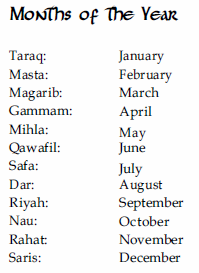
The five Holy Days all occur at the end of the sixth month, Qawafil, and are known as Ahad, Atnen, Salas, Arba, and Yasad. Yasad is known as Ascension Day and marks the founding of the Caliphate, and all new Caliphs are officially crowned on this day. Events on the Holy Days differ based on culture and region, but are typically times of fasting and self-reflection broken by feasts upon completion. The Festival of the Pearl, for example, takes place during the Holy Days.
Handouts & Maps
These are not found in any of the three books proper, but are leaflets in the Land of Fate boxed set. 14 of them are maps with descriptions and legends on their backs, detailing specific areas in Huzuz or more generic ones such as a city marketplace, an oasis, or common residential dwellings. 1 illustrates common dress for occupations and social classes, while 2 go into detail on what kinds of possessions can be found among al-Badian nomads and their tents.
I’m not going to show all of the handouts, but they are quite decorative and useful. Here’s a few below:
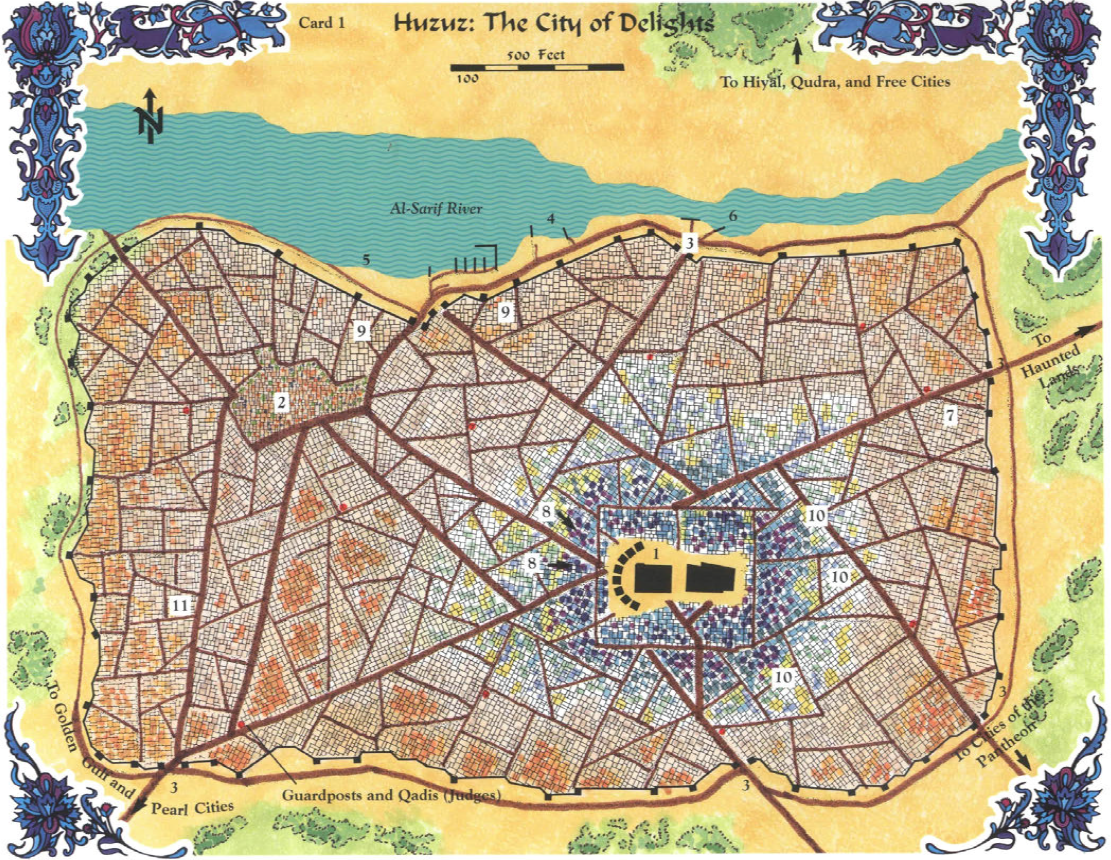
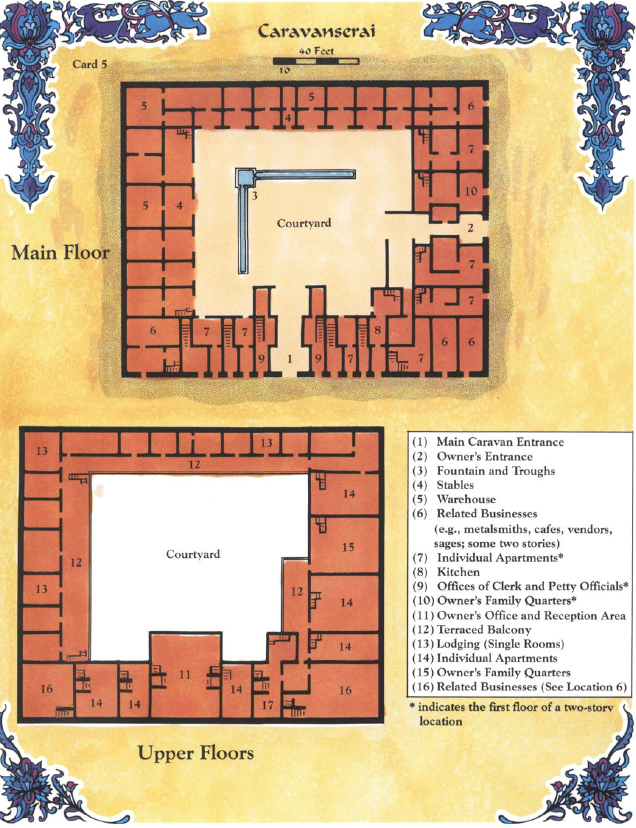
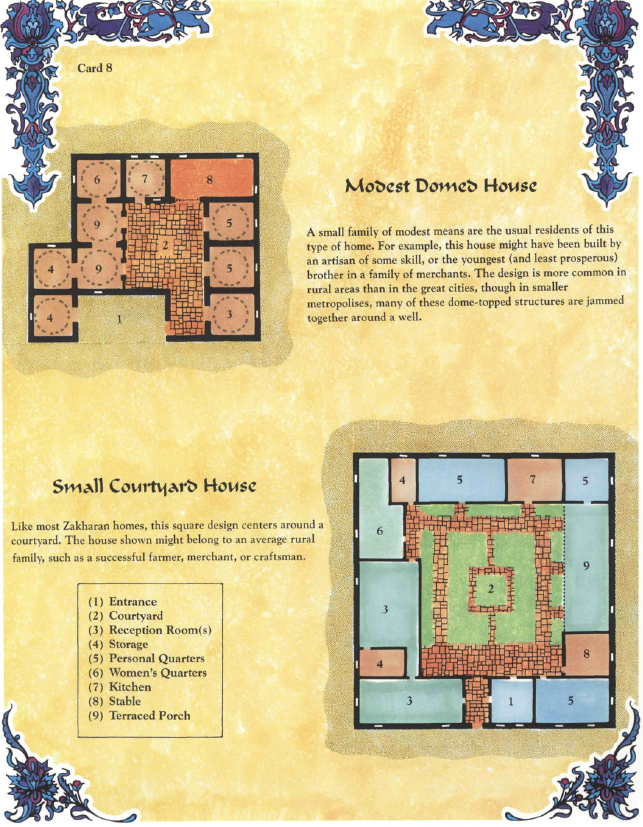
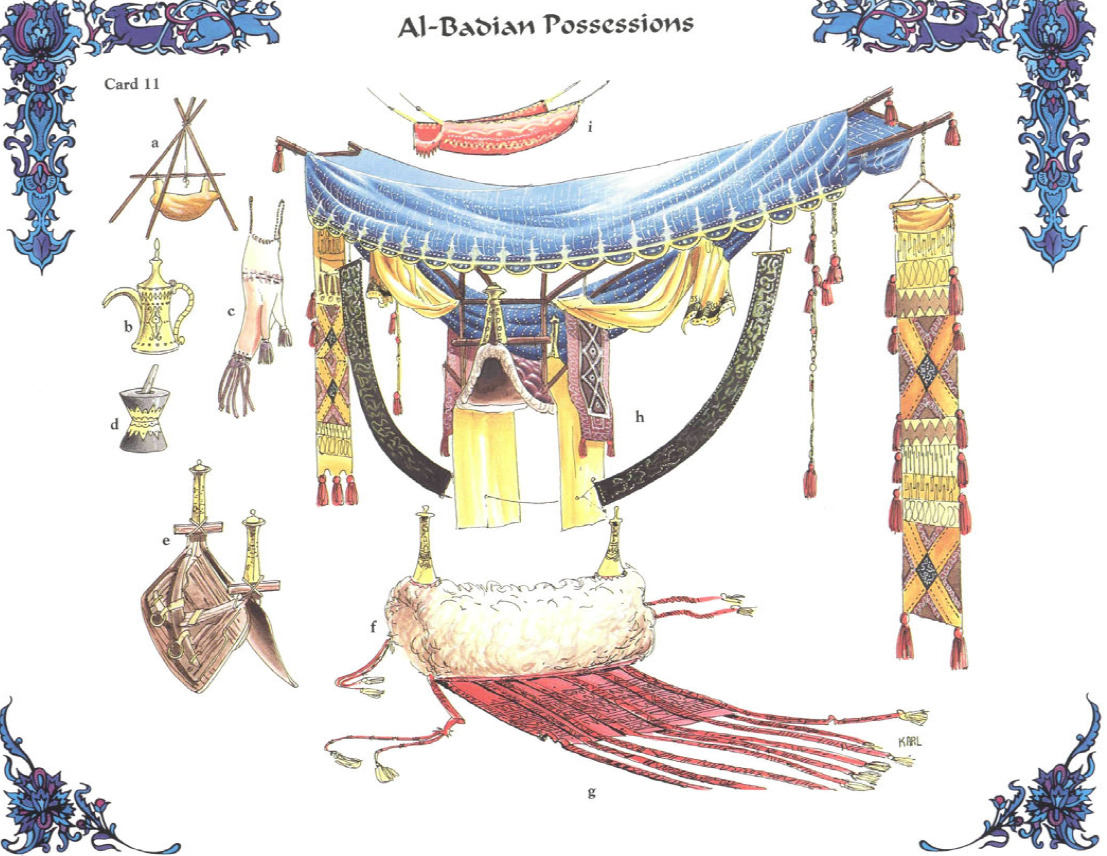
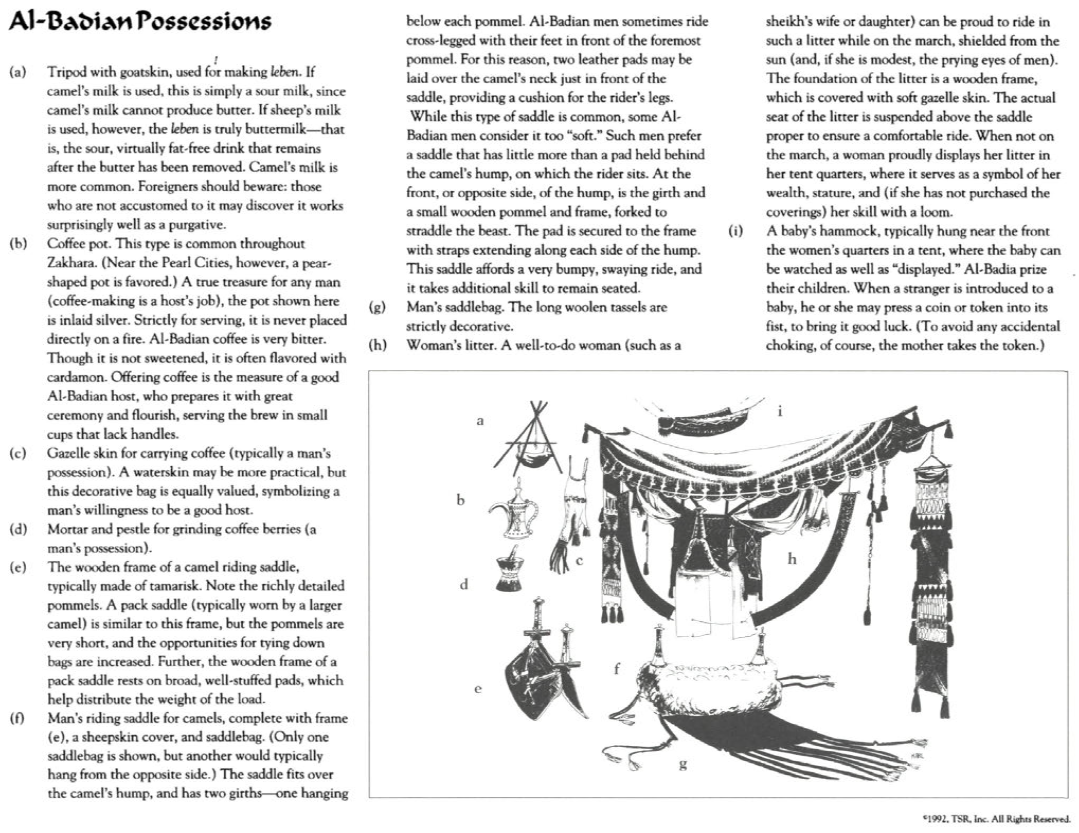
The Zakharan Continent
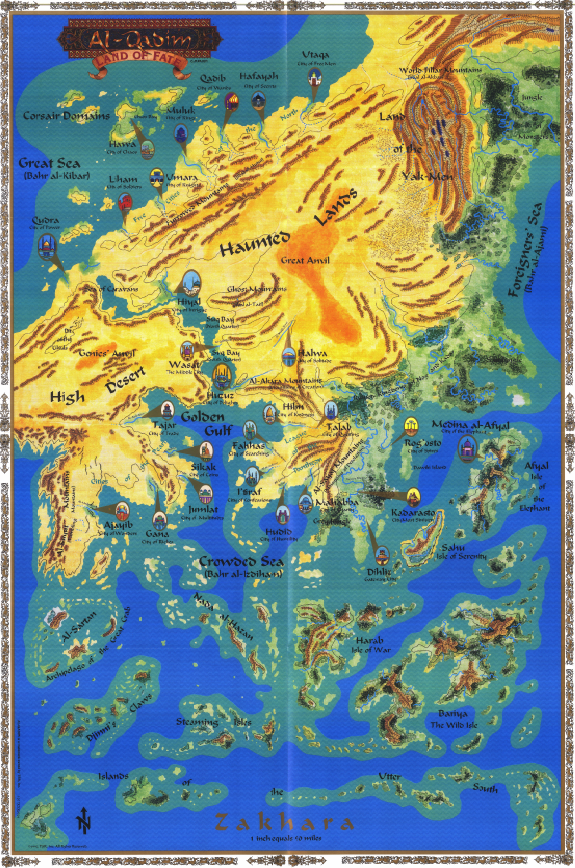
We have a full-page illustration of the Zakharan continent and the many islands off its coasts. We have two maps: the first gives a zoomed-in view of the Suq Bay and inland Sea of Caravans which touches the Cities of the Heart, Cities of the North, and shows much of the High Desert; the other focuses on the Pearl Cities and the League of the Pantheon. The latter two maps are useful, but happen to cut out quite a bit of eastern Zakhara, which includes the Haunted Lands and Ruined Kingdoms.
Thoughts So Far: I don’t have much to say at this point that I haven’t said above. I do enjoy the five tales, and they feel thematic of an Arabian Nights style setting. It does paint 3 of the 8 Major Gods as vindictive and predatory pricks, threatening to kill innocents if a woman is not married to one of them. But perhaps it’s to demonstrate that the wisdom of the Law changed them for the better? That’s my guess at least. The part on languages did not wow me, and while I do like some of the phrases I cannot see the Arabic* as being something most gaming groups will muster to remember beyond one or two favorite words or sayings. The maps aren’t anything special by modern standards, but in the early 90s I imagine they’re highly useful for getting a sense of Middle Eastern-style locations.
*Arabic-sounding, I am not fluent in the tongue.
Join us next time as we cover the DM-centric booklet, Fortunes & Fates!
Fortunes & Fates
Original SA post
Fortunes & Fates
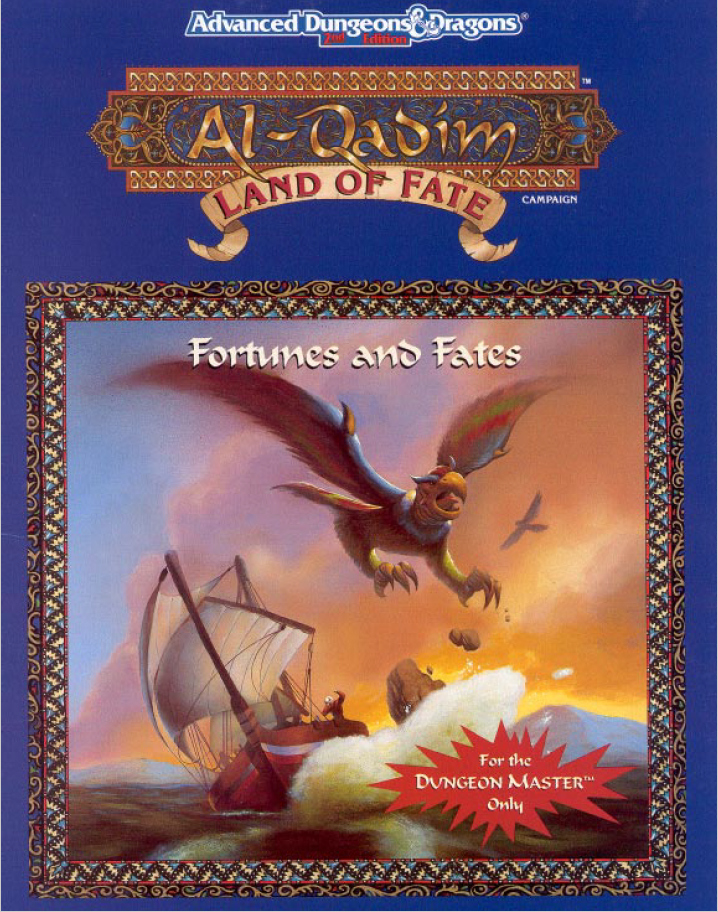
This five-chapter Dungeon Master’s booklet is far shorter than the Adventurer’s Guide, sitting at around just 60 pages.One of those chapters, Secrets of Zakhara, we folded into the review regarding the various cities. Due to that, we’ll be mostly covering organizations and magical items in this post.
Our introduction covers movement rates for terrain to be used in conjunction with the map of Zakhara, including unique types mentioned in Chapter 1 of the Adventurer’s Guide. I’ll admit that I never really used travel times in D&D games myself, save when time was of the essence.
Chapter 1: High-Level Characters
In pre-3rd Edition D&D, attaining at least 9th level set you with various perks of temporal power. The Land of Fate is no different, although the specifics for certain classes differ a bit.
Fighters don’t need to form a stronghold or castle, but must have a regular place of contact for men-at-arms to come under his banner who can be disbanded and reformed in reasonable timeframes. The latter case is meant to help PCs of a more transitory nature, and there’s even separate tables based on terrain type (Desert, Sea, and City/Village) for this: Class kits are askar (village warrior), desert rider, or corsair depending upon the PC’s preferred area of operations.
Paladins do not gain followers, but can hold land in the name of the Grand Caliph. Rangers can attract followers from animals of both the mundane and supernatural variety in addition to human/demihuman/humanoid types.
Mages often use highly personalized titles such as “Zibaru the Wolf” as opposed to the more generic “archmage,” and can gain apprentices even without a base of operations. However, should a mage choose to set up such a domicile they often gain status as a magical advisor to a local lord in exchange for supplies for spell research.
Priests gain fighter followers who are extra-devoted with high Morale scores in addition to more normal followers of their class kit. Clerics of Order who belong to one of the three philosophies carry their own perks and responsibilities: pragmatists are encouraged to travel the land and carry their teachings to places far and wide. Ethoists gain orders from higher-ups to settle down in an existing church or build up a new one with leaves of absence allowed if the need is great. There’s no mention of any unique duties for moralist priests, but I presume they’re similar to ethoists. “Free” priests (hakimas, kahins, and mystics) can build churches, but do not have funding from a hierarchical organization and must raise the money themselves or from the local community.
Thieves can attract followers, although it is possible to recruit ones from other thief class kits, such as a holy slayer who needs some merchant-rogues to launder money for a business front. Bards of 8th level are asked to join a local ruler’s court as an entertainer and advisor, and can receive free room and board should they accept. This is rarely a permanent occupation. At 9th level, bards can attract followers of their own and can even treat a ruler’s court as a base of operations/recruitment area. Followers are still low-level, so no gaining the 12th-level sha’ir advisor as a minion! Bards can even gain special followers such as talking animals as icing on the cake.
Chapter 2: the Law
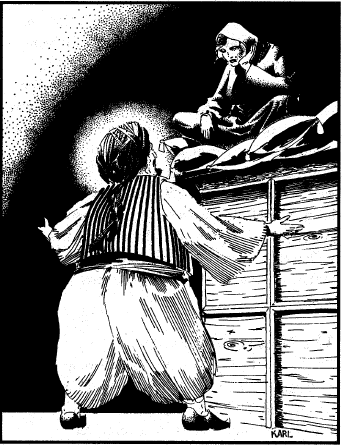
This chapter goes into a bit more detail regarding the Law of the Loregiver, and more importantly the aspects most relevant to typical PC groups. In pre-Enlightenment times, the land of Zakhara was politically divided between many warring factions. There were priests of gods, but they were selfish and withheld vital magic unless it benefited them. Monsters, plagues, and famine were widespread, and all seemed lost before a young man found the Law of the Loregiver in a cavern. The beliefs of tolerance and unity helped people set aside long-held grudges, and the gods who accepted the Law worked together to set up universal rules and mosques open to the public. The original scrolls were copied onto lacquered wood in the Golden Mosque of Huzuz, and copies of said blocks are installed in the creation of new mosques.
The Law has several well-known commonalities: the previously-discussed aspects in this and prior sections of the review, but also proper means of religious worship, veneration, and the nature of all things divine. The second part gives a “Mandate of Heaven” style rule for leaders, from the Grand Caliph down to local administrators: a leader rules by the permission of the led, and a leader who fails to perform in a wise and just manner can be replaced by a worthier candidate. Finally, the Law codifies various moral fables, rules of conduct, and existing laws and traditions into a legal codex. In regards to this last part, actions are split up into five tiers:
That Which Is Forbidden: The most heinous of crimes, which most often result in capital punishment. Eating sapient flesh,* murdering innocents,* treason, theft to the point that it’s life-ruining to the injured party, enslaving the Enlightened,** and spreading claims that no gods exist.
*Murdering slaves counts as property damage.
**as an individual; the government can enslave criminals and debtors, and mamluks are by default Enlightened slaves.
That Which Is Discouraged: Crimes which some degree of restitution can be made. Small-time theft, assault, justifiable homicide, fraud, slander, and making the jobs of government officials more difficult but not on a treasonous scale.
That Which Is Tolerated: Basic activities expected of Enlightened society. Earning a living, partaking of holidays, and free speech that isn’t pro-atheist, slandering others, or threatening government officials. Interestingly, one can take out loans and even drink alcohol unlike the real-world Islamic Caliphates, although getting drunk to an excessive degree in public is a Discouraged act.
That Which Is Encouraged: Things which mark someone as a good citizen and can get preferential treatment by the system. Said actions are not necessarily mandated. They include acts such as worshiping Enlightened gods, bringing Enlightened values to the Unenlightened, charitable works, and paying one’s taxes.
Wait, paying taxes isn’t a requirement in the Caliphate? I can see a bunch of merchants from Faerûn and Kara-Tur setting up shop in Zakhara as a tax-free haven!
That Which Is Required: These actions are mandatory for all citizens to perform; refusal to perform them is often a high crime. Required acts include obedience to the Grand Caliph, pilgrimage at least once to the city of Huzuz, and belief in a higher force, “be it a common or Enlightened god.”
The quoted part confuses me. In Chapter 5 the term ‘common god’ also covered Enlightened gods, and worshiping Enlightened gods being merely Encouraged. It makes me wonder as to the legal status of Unenlightened people in Zakhara; while there are foreign traders who can ply their trade like those priests of Gond in the aforementioned Chapter, I presume that this example is done more out of convenience for the farther-north cities. Most of the time the setting presents hostile relations with Unenlightened civilizations, not to mention the commonality of their enslavement. I suppose it’s meant to be a ‘lead by example,’ given the mention of tolerance, open mosques, and “bringing Enlightenment to the Unenlightened” presupposes honest attempts at conversion initially. Or it could be an aspect of Zakharan law which is often bent based on the convenience of local rulers.
We end this chapter with discussion of Justice and the Law when PCs run afoul of it, along with penalties for common crimes. There’s a sample table for a base chance of conviction, with modifiers based on various aspects of individuals’ social standings, the strength of pieces of evidence, and the amount and credibility of witnesses. There’s some interesting peculiarities in Zakharan law I’ll outline below:
1. The concept of a ‘diyya,’ or blood-price, is a monetary amount paid to the wronged party or their next-of-kin as part of or in addition to existing criminal penalties. It’s commonly employed in the event of death from murder or negligence. Communities with access to resurrection magic often use the proceedings from a diyya to pay for the material components of said spells.
2. Crimes committed by a slave must be covered by a master, and slaves themselves can be used as payment in the event of the penalty being a fine. This causes many slave-masters to either keep a very close eye on the day-to-day lives of their slaves.
3. Magical evidence must first be verified by an expert spellcaster to test its validity. This is done as a countermeasure against enchantment, illusion, and other such spells that present a skewed reality.
4. Genies have their own courts and legal systems which are more harsh for mortals. Genies of any clan cannot be used as a witness to a crime in mortal courts. A genie who commits a crime against Caliphate citizens must be tried in a genie court, but a mortal who commits a crime against a genie will be tried in genie court. This doesn’t explain how this affects sha’ir and other spellcasters who use a genie to commit crimes; this sounds like a big loophole. It’s also not mentioned if this is part of some deal or pact on the part of the Caliphate, given prior examples of genie soldiers, laborers and advisors in the more prosperous courts and cities.
5. Mamluks and holy slayers have their own special courts to judge wrongdoing by their own members. Mamluk military tribunals are already part of the Caliphate’s legal system, but it’s possible for a mamluk who is declared innocent in a civilian court to be tried guilty in a military court.
6. Dismemberment is a common punishment for major crimes. Regenerating lost limbs of a convicted criminal is itself punishable by an equal dismembering of the appropriate limbs.
The text does mention that being convicted of a crime worthy of capital punishment can be a real bummer and should only be done for PCs who have demonstrated particular foolishness in their actions. Otherwise, it can be used as a springboard for the other PCs to help clear their unlucky fellow’s name, or said PC escaping from prison by chance of Fate to do the same.
Chapter 3: Power Groups
This chapter’s name is a bit of a misnomer. It does cover important organizations in Zakhara, but ones which aren’t necessarily bound to any one area, city, or tribe. They detail organizations strongly correlated to various classes and class kits: Mamluk societies, Holy Slayer fellowships, Mystic groups, and the Brotherhood of the True Flame. Each section not only details notable organizations, it contains advice for gaming groups on how to make their own, either as DM or a PC forming a new movement.
Mamluk Societies
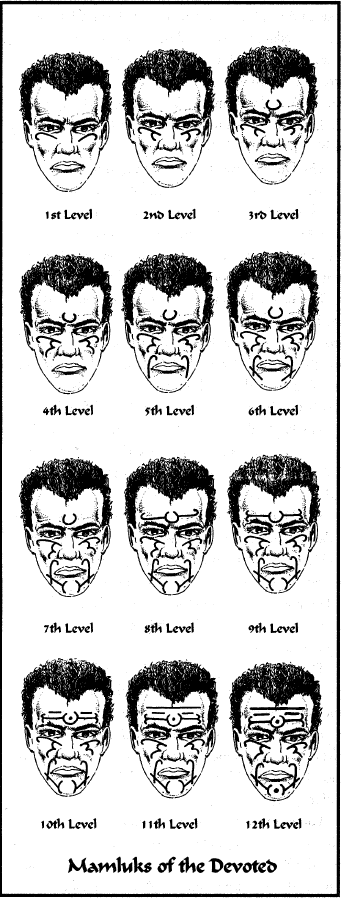
Mamluk organizations are an omnipresent sight across Zakharan civilization. They are most numerous in the northern borders where Unenlightened raids are the most common, but can be found in appreciable numbers as far as the Ruined Kingdoms. They have the least power in the Pearl Cities, whose rich lords and ladies prefer private guards and well-funded local militias for protection. Also importantly, mamluk units are owned by the Grand Caliph and answer to him. As such they act as a political counterbalance against the ambitions of local rulers: the presence of mamluks supplies security of highly-trained soldiers, but ones who do not ultimately answer to the regional sultan or sheikh.
The duties of mamluks vary; while they can and do answer the call as soldiers of war, in times of peace they serve as guards for public facilities, bodyguards for important people, and patrolmen for trade routes. Mamluk societies are hierarchical military affairs where units are organized into typical formations (a platoon has 10 soldiers and 1 sergeant, 3 platoons make a company, etc). They all bear facial tattoos designating the society in which they serve, and barring a rare few exceptions they do not accept adults into service: Unenlightened children captured as slaves are raised into the role from a young age, and their surnames reflect their society. For example, members of the Dutiful, Wajib, add “Abd al-Wajib” meaning “slaves of the Dutiful” in front of their personal names.
We have 14 major mamluk organizations listed: the Dauntless and Faithful (guard the Grand Caliph in Huzuz); the Defenders (rule Qudra), the Devoted and Exalted (rival societies in the League of the Pantheon); the Devout (Ruined Kingdom society who replaced a detachment of Devoted when the latter pledged their allegiance to Kadarasto’s prince for protecting pre-Enlightenment ruins), the Dutiful (the most numerous and powerful mamluk society with members in all major cities), the Honored (male eunuchs and female guards of the Grand Caliph’s harim), the Parched (watch over Talab’s water supply, have been subverted by wererats), the Respected (old and respected organization in the Free City of Muluk), the Studious (Qudra-based, are skilled in communication and espionage), the Valiant (fast, mobile Qudran soldiers), the Wanderers (mostly naval soldiers in Qudra), the Wondrous (palace guards of Afyal, whose Padisha prefers to use them for aesthetic military parades to the consternation of said society’s commander).
Holy Slayer Fellowships
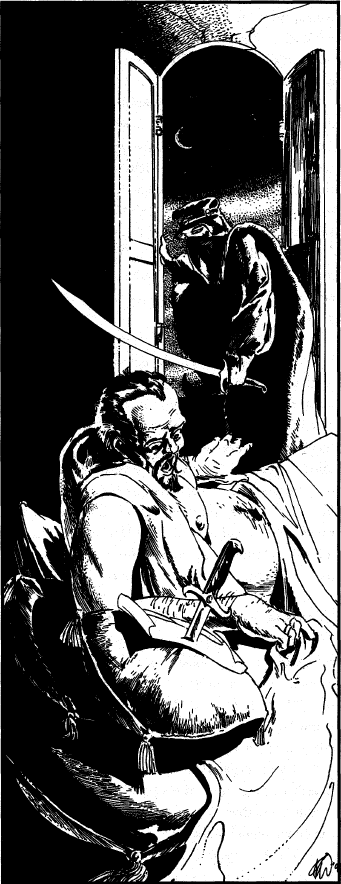
Holy slayers are individuals whose duties emphasize the dominion of one of the Enlightened gods, using roguish skill and martial steel to eliminate threats to the faith. They are a controversial aspect of Zakharan society, and their relationship with the orthodox faith and lay worshipers of their patron deity differs widely. In some lands they are viewed as dangerous fanatics and outlawed, making the assassins a hidden estate who accept social ostracism as the price to pay for vigilance. In some places they may be tolerated as a necessary evil, provided they keep out of sight and mind. Regardless, holy slayer organizations are known as Fellowships, and one does not go seeking them out for membership. The slayers come to you, with a dagger either for your hand or your heart.
Notable fellowships include the Everlasting, whose “Caliph of Shadows” rules from a mountain fortress and dispenses punishment to the Caliphate’s movers and shakers should their moral standards come up short; the Final Chord, Unenlightened followers of Bala who lead insurgent groups against the League of the Pantheon; the Flamedeath Fellowship, who while venerating Najm have a schism among their number who secretly wish to convert to the fire god Kossuth and thus seek an alliance with the Brotherhood of the True Flame*; the Friendly Word, Zannite devotees who ruin reputations and economies in lieu of violence and have a cool calling card of a pen-shaped dagger they leave in the beds of their targets; the Gilded Palm, worshipers of Jisan who are little better than mercenaries who act against anyone that may stymie free trade**; the Grey Fire, worshipers of Najm in the Pearl Cities who devote their talents to acting as typical adventurers and help chart maps and details of Unenlightened lands; the Moon-Spinners, an Afyal-based order whose primary mission is reducing the influence of the Lost One’s subtle magics on the island; the Soft Whisper, an all-female order who primarily recruits members from the Grand Caliph’s harim and take on missions they believe are in said rulers’ interests; the Storm Which Destroys, the League of the Pantheon’s “shadow army” who specializes in quelling internal disputes among said geo-political bloc; the Wind of Fate, an all-male order who recruits members from the desert tribes and monitors those wild lands for dangers beyond the al-Hadhar’s reach; and finally the Wrath of the Old, Kor-worshipers based primarily out of the north whose methods and motives are mostly unknown besides striking down threats with extreme prejudice and overwhelming numbers.
*Which is odd, given that based on earlier descriptions and the Brotherhood entry proper later in this chapter, the fire mages don’t seem to have any loyalty to the gods and view divine casters as rivals.
**you’d think that they’d worship Jauhar instead, given the focus on wealth.
Mystic Groups
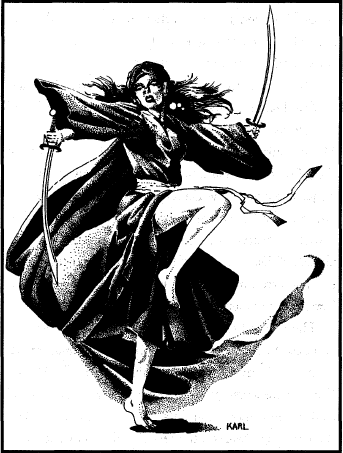
Mystic organizations exist outside of the typical Clerics of Order hierarchy in the Caliphate. They are small sects which grow like mushrooms; short-lived, but explode onto the scene at the most opportune times. They tend to prefer the environs of the desert and rural communities; even when they coexist alongside churches in the city, a prior track record of conflicts with orthodoxy discourages habitation in large population centers. Mystics primarily honor one deity based upon their methods of enlightenment.
Notable Mystic groups include the Dancing Dwarves, dervishes who favor battleaxes when fighting in dancelike rhythms; the Dome Dancers, who help watch over the Desert Mosque, guard travelers against monsters, and believe that the nomadic way of life is far more moral and noble than that of sedentary living; the Readers, Zannite devotees who gain enlightenment from the act of reading as many sources of texts they can get their hands on; the Chant Masters, who live in the hills of the Pearl Cities and find religion in the ecstasies of music and song; the Court of Rhythm, common in the Ruined Kingdoms and island settlements who channel divine power through drums; and the Quiet Multitude, worshipers of Selan who meditate in moonlight. The Quiet Multitude was once a Caliphate-wide religious movement a century ago, but ended up fracturing into sectarian schisms which drastically reduced their power.
Elemental Brotherhoods

Although Zakharan magical traditions recognize four elements, the non-fire elemantalists are for the most part unorganized. They typically join existing noble courts, magical universities, and the like rather than forming organizations dedicated to their spellcasting style in and of themselves. This is due to the fact that the Brotherhood of the True Flame views such attempts as a dangerous threat to their power, and have been particularly vicious in crushing such potential opposition where they can. It will take the actions of a PC to build their own
The Brotherhood of the True Flame believes in a doctrine of elemental supremacy; fire magic is the only form of magic worthy of devotion, and all other kinds must be crushed for their eventual plans of world domination. They are a hierarchical society whose existence is publically known and banned in the Caliphate, but whose members operate in secret. Their leader, Nar-Aidiya, is a 20th-level fire mage whose base of operations is a magically-guarded fortress deep in the Haunted Lands. We get a rundown on some of their other VIPs, ranging from a wanted assassin who the sultana of Hiyal wants brought back, a slaver who is notable for finding new recruits for the Brotherhood, a hot-tempered wizard who challenges others to duels at the drop of a hat, and a holy slayer leading the Flamedeath fellowship.
Chapter 4: Secrets of Zakhara
This chapter covers all of the secrets of the various cities in the Adventurer’s Guide. There are no secrets for the Nomadic Tribes, oddly enough. I suppose the writers figured gaming groups would lean more towards urban styles of campaign.
Chapter 5: Magical Items

This is by far the most detailed chapter in Fortunes & Fates. With such an innovative high-magic setting, it’s only proper that we have a bevy of new magic items to go along with it. How much are there? 17 weapons, 3 sets of armor, 4 shields, 12 potions, 11 scrolls, 7 rings, 7 rods/staves/wands, and 19 miscellaneous items, all with new d100 tables accommodating all of them! Quite a bit are renamed existing items to better fit Middle Eastern aesthetics, but most of them are brand new. For reasons of brevity I will not go over them all, but instead highlight items I find particularly interesting.
Cutlass of the Golden Gulf: You can breathe underwater as long as you hold this weapon in hand.
Dagger of the Evil Eye. A cursed weapon which bestows the evil eye upon its wielder with the first strike they make in combat.
Mamluk Sword of Obedience: A struck human, demihuman, humanoid, or giant must make a saving throw vs spells or be affected as if Charmed and immediately surrender to the sword-bear, provided that the wielder has more Hit Dice/levels than the target.
Genie Slayer Sword: This +2 sword is +4 against any genie as a basic function, but individual swords are designed to deal double damage against a certain genie clan.
Sword of the Believer: Inflicts damage only against creatures that are not Enlightened and passes right through the bodies of Enlightened targets struck. The text mentions that it is useful when cutting one’s adventuring buddy out of the stomach of a creature that swallowed them!
Armor of the Desert Evening: This lamellar armor can be worn in hot environments without ill effect.
Shield of the Holy: This +1 shield becomes +2 when in the hands of a priest dedicated to the deity inscribed upon it. They also turn or command undead as if they were 2 levels higher.
Potion of Dreaming: When you drink this potion before sleep, you’ll receive a dream providing advice on how to obtain some item or goal which you desire.
Oil of Great Devotion: When applied to a priest, their level for the purposes of to-hit bonuses, spells, and turning undead increases by 1 to 3 based on their level (lower bonus for higher-level priests) for the next 12 hours.
Oil of Obedience: When smeared against the forehead of a sleeping target, they become obedient to you for 24 minus 1d6 hours, following simple orders and tasks in a zombie-like fashion.
Oil of Romance: A love potion, but is poured across a doorway or window and the pourer utters the name of an individual, Said individual becomes subject to a powerful Charm Person and becomes romantically devoted to the oil-bearer on a failed save. This effect can only be removed via Dispel Magic or Limited Wish.
Cursed Scrolls: Interesting curses such as turning into a donkey where only a hakima (wise woman) can see your true form, being stalked and pranked by a mischievous djinni, or a blank scroll which sprinkles glitter as it’s opened:
quote:
This does nothing, but makes players very paranoid. The DM may call for additional (ignored) saving throws from the PC who opened the scroll at random moments to convince the player that something is afoot.
The curse is DM fuckery!
Grant: Is actually a nonmagical item, but has a list of various titles, deeds, and other adventure hooks for PCs. Permission to audit a local ruler’s tax records in the name of the Grand Caliph, enter said Grand Caliph’s court as an ambassador, a patch of land worth 1-12k gold when presented to a local ruler, and permission to establish a town/mosque/etc in a wild location are but a few possibilities.
Scroll of Protection from Divination: Automatically foils all divination spells targeted against the drinker and all things within 10 feet of their position.
Ring of Avian Control: Can completely dominate up to 40 Hit Dice worth of birds with Intelligence of 4 or less.
Ring of Genie Summoning: Like Aladdin’s Lamp, but in ring form. Can summon a particular genie, who must serve the summoner faithfully after which the ring no longer works. There’s a 4% chance said genie is capable of granting 3 wishes to the summoner.
Ring of Message: A common fixture in the Caliphate’s bureaucracy. It is activated by a command word, acting as a magical audio recording device. When the command word is spoken again the speaker’s message is relayed as an illusory duplicate of their face utters the message three times after which it erases said message and can store another one.
Ring of the Holy Slayer: Worn by fellowship members as a magical cyanide pill equivalent. A command word pumps a deadly poison into the wearer’s hand. Those who die from said poison cannot be raised or resurrected, and their spirit will not answer the calls of Speak With Dead and similar divinations.
Rod of the Monolith: This rod allows the wielder to control entities summoned by the Elemental Monolith spell. This is based off of the Unleash Monolith spell from Arabian Adventures, which creates a barely sentient, highly destructive 30 Hit Dice elemental after 1 day of meditation and chanting. Said monolith normally enters a destructive rampage when summoned.
Banner of Renown: This flag displays a moon and trailing stars, the national symbol of the Caliphate. All Enlightened creatures within 100 feet of the banner gain bonuses to morale checks, to-hit rolls, and damage rolls.
Carpet of Fighting: This magical carpet will not take you for a ride. Rather, it will choke a target of your choice to death.
Genie Prison: Commonly taking the forms of lamps, bottles, ewers, and geodes based upon the target genie type, sha’irs make use of said items to capture genies. Imprisoned genies are often commanded by the item’s magic to perform a specific task upon release, determined randomly via d100 roll.
Qanun of Quiet: A radius of magical silence emits as long as this instrument is played. It is more akin to a barrier, as those within the radius can hear others inside normally. It also has a similar effect of protection against divination spells directed from outside.
Telescope of Fantastic Vision, and Telescope of True Vision: Both of these items are magical spyglasses who act as a Gem of Seeing to whatever is viewed through the lens. However, the Telescope of Fantastic Vision is cursed, and after 4 uses will only show near-unbelievable scenes wildly inaccurate of the truth.
Thoughts So Far: This booklet is full of highly useful material. The magic items are both practical and flavorful, while the rules for followers and the legal system can see use in a lot of campaigns set in Zakhara. The organizations are perhaps the weak point: the mamluk societies are rather brief and lack the intrigue, factionalism, and adventure hooks we’ve seen in the city chapters barring a few exceptions. A few don’t really have any particular distinguishing factor besides how they fight or where they’re located. The Mystic groups are a bit similar in this regard, who mainly differ by how they pray for spells rather than ideological reasons.
The Holy Slayer fellowships were a step up in that they can make for both interesting patrons for anti-hero PCs and serve as ready-made antagonists. They more or less have specific tasks which can tie into adventure hooks, and I do like how a few have fallen from their lofty ideals, such as a faction of Flamedeath heretics (and the leader of the group as a whole!) allying with the Brotherhood of the True Flame.
The Brotherhood of the True Flame is the only real “mage organization,” but they make up for it by serving as one of al-Qadim’s Big Bads. Their entry has thus more room in detailing their most prominent members and ways adventurers would most commonly encounter them. The Brotherhood’s mentioned several times earlier in the Adventurer’s Guide (and the Secrets Chapter in this booklet) with other NPCs, so their brief entry here is more than made up for elsewhere.
Join us as we cover the final booklet of Zakhara, showcasing its homegrown monsters in the Land of Fate!
Land of Fate (Bestiary Booklet)
Original SA post
Land of Fate (Bestiary Booklet)
The smallest of the three, the oddly-named Land of Fate booklet gives us 11 new monsters (5 if you don’t count subtypes) of setting-specific monsters.
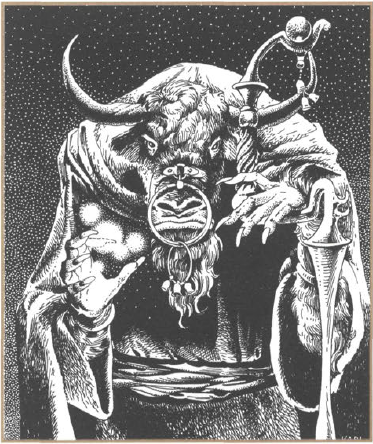
Yak-Men (Yikaria) are inhabitants of the World Pillar Mountains. Their civilization is advanced and they are naturally gifted in the ways of magic, but they are a tyrannical society powered by the labor of slaves of other races. They do not interact much with the outside world save among spies and agents, which gives them a sort of fearful fabled status in the Caliphate as wicked and powerful savages.
Yikaria society centers around the cities in their mountain homes. Slaves outnumber them 5 to 1, and yak-men of all social classes have at least one servant. Dao servants are used to shape terrain and structures with exotic imported stone from the Elemental Plane of Earth, and military outposts guard key roads and vales traversing the mountain range. Their cities are a centralized empire, and their patron deity’s name is forgotten among all but the yak-men who do not speak his title in the presence of outsiders. This Forgotten God is their leader and demands daily sacrifices of slaves, culled from those who are incompetent and disobedient first and killed one of four elemental ways (pyres for fire, thrown off a mountaintop for air, buried alive for earth, and drowning for water).
Yak-men encountered outside of the World Pillar Mountains are typically scouts who have been exiled and can only have their crimes forgiven should they bring some valuable object or piece of intelligence back to their home city. They often make use of the Magic Jar spell to inhabit the bodies of other races to better blend in among Zakharan society.
Statwise the Yikaria are 5 Hit Die creatures who specialize in magical abilities: they can use any magic item without restriction, can command a dao genie 1/day to perform any task asked of them for 48 hours, have a touch range magic jar spell that only affects demihumans, humans, and humanoids but also grants the memories of the host body in addition to control over its motor functions. The yak-man’s presence cannot be detected by divination spells in such bodies, but can be dispelled normally.
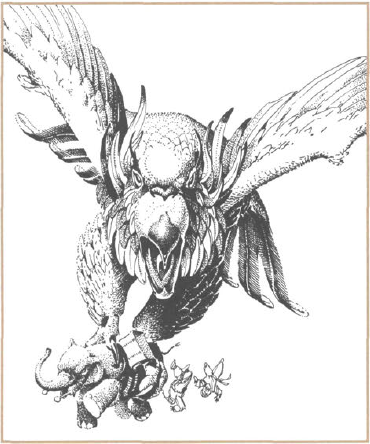
Zakharan Rocs are more varied than the ones found in other lands. They typically live in the lusher regions of the Land of Fate, favoriting the Ruined Kingdoms region. Their plumage is a beautiful multi-colored hue, and a rare few have pure white, black, or red feathers. Beyond the common roc there is a two-headed variety, and a great roc which is the largest specimen of all.
Two-headed and great rocs are sapient, unlike the common variety, although the two-headed ones are Chaotic Evil and sadistically hunt beyond what is necessary for subsistence. Both they and great rocs are large enough to pick up and fling boulders and boulder-sized objects as ranged attacks.
Statwise there’s not much to say about the new roc varieties that separates them from the normal kind beyond larger dice numbers (and a bonus bite attack for the two-headed one). They’re big, tough flying animals with natural weapons and a ton of Hit Dice.
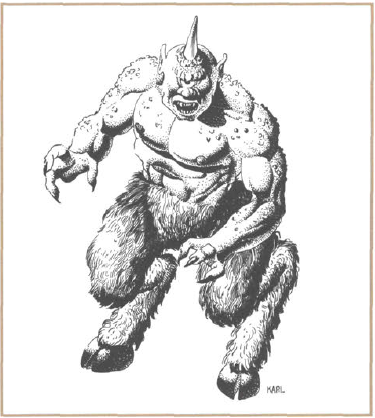
Island Giants are huge (13 feet tall), evil, horned beings who have varying physical features based upon their local ecosystem. Some have reptilian scales, others one or more horns, and some have features of other races such as a cyclopean single eye or the hindquarters of satyrs. They are hostile to other giants and enlightened civilization, and the feeling is mutual. Island giants speak a dialect of Midani peppered with Giantish phrases, and prefer to live by themselves save when they must come together to mate. The women of their species have the ability to polymorph into other human and humanoid (but not demihuman) forms and use this to lead travelers astray. Island giant children are able to breathe underwater to take advantage of fleeing into safe areas in coves, but lose this ability upon reaching adulthood.
Statwise they are tough 13 Hit Dice giants with the ability to throw boulders. They have some slight Magic Resistance at 10%.
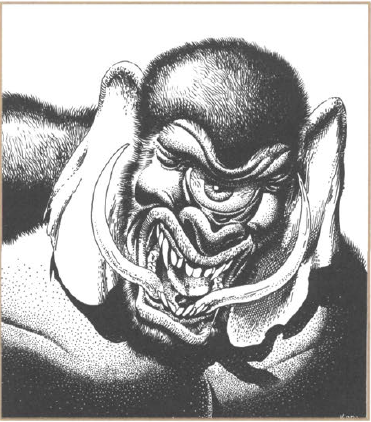
Ogre Giants are even larger specimens of normal ogres, averaging around 20 feet tall with a single eye and fur covering their bodies. They keep cool by flapping their huge ears, and the males can grow tusks. They can speak Ogre, and some closer to civilization learn Midani, although most of their number is Unenlightened and are given a wide berth by others. A notable few converted to the Law of the Loregiver, becoming missionaries to the rest of their kind.
Ogre giant society is organized into small family units led by a male leader who has several wives. Some often serve as minions to ogre magi, spellcasters, and other powerful individuals in exchange for food, territory, and protection. Interestingly they demonstrate a level of honor towards their foes; any slain by an ogre giant will be buried in rock cairns, which they bury their own race in as well. The cairns are built upon with successive generations, a few becoming building and even palace-sized tombs.
Note: Each of the genie entries has 2 pictures instead of one, portraying a male and female of their clan. I’m only choosing 1 for each entry for brevity’s sake.
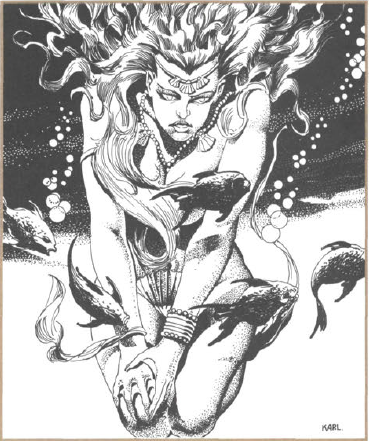
Zakharan Marid Genies are considered by many in the Caliphate to be the most powerful of geniekind, and the marid’s impressive egos bask in this. Marids wear little or nothing in aquatic environs, but when they come upon land bound mortal society they dress in the most expensive and flashy garments they can find. Every marid claims to bear some noble blood, and titles of authority are practically part of their naming structure. Their family units are extended households of 2 to 20 members, with twice as many servants or slaves of other races who are given magical boons and water-breathing ability as part of this service. The marid take great pains to gain possession of the finest things in life, be they magical items, irreplaceable works of art, or anything that speaks to the individual marid’s hobby. Their capital is the Citadel of the Ten Thousand Pearls, a beautiful city in the center of the Elemental Plane of Water.
Statwise they are physically powerful 13 Hit Dice genies with lots of spell-like abilities. They are immune to water-based spells and are resistant to cold-based attacks. They, and all other non-Janni genies, can travel freely to any of the elemental planes and the Material Plane, although they avoid the territories of other genies save in times of need. Once per year they may cast Alter Reality.
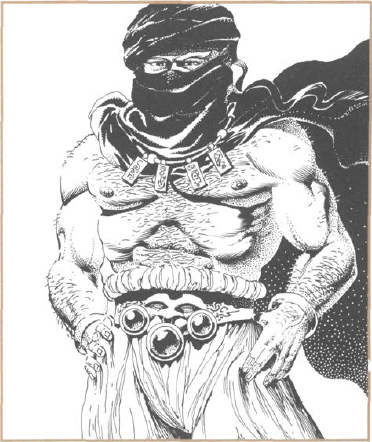
Zakharan Janni Genies are the only subrace native to the Material Plane. They are servants of the other genie races and watch over the Land of Fate’s great deserts. They appear as human or half-elves with aesthetically pleasing features, capable of walking among mortalkind in disguise. Janni prefer to live as part of their own nomadic tribes away from others, although their leaders are allies of the Grand Caliph. They maintain a few permanent settlements, and they follow similar leadership structures as Zakharan mortals: sheikhs rule over smaller tribes, while amirs lead the larger ones and maintain a council of viziers. The janni are friendly to the djinn, but barely tolerate dao and efreet. They hardly ever deal with marid, but give them the proper amount of “royal treatment” during their stays.
Statwise janni are 6-9 Hit Die (more for sheikhs, viziers, and amirs) creatures who gain 20% magic resistance while in a desert environment. They can Speak with Animals at will to aid in their role as guardians of nature, and have a minor variety of spell-like abilities such as turning invisible, ethereal, and creating food and water along with permanent flight and water-breathing.
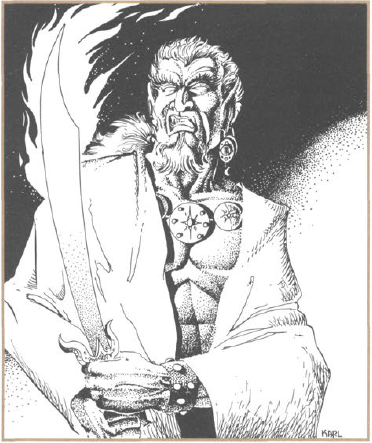
Zakharan Efreeti Genies are evil social Darwinists who react to others based on their perceived power in relation to themselves. Most live in the Elemental Plane of Fire, and the few that do show up in the Material Plane are on some mission or service for a sha’ir or higher-ranking efreeti. They are prone to hold grudges and their society is highly militarized. The City of Brass is the efreeti capital, its soldiers making frequent raids into other planes for riches and slaves. There is a cruel irony that many efreet are not fond of their own society’s restrictive nature, and are eager to visit other planes when permitted for the relative freedom this brings. The efreeti’s relative willingness to grant wishes to mortals has led to the subject of many tales, and there’s an entire bureaucracy overseeing the wish trade in order to maintain their races’ power and reputation. Although the system favors the efreet, it is difficult yet possible for mortals to find loopholes and exploits to get out of a badly-worded wish.
Statwise efreeti are 10 Hit Die genies with powerful spell-like abilities. They are immune to nonmagical fire but take half damage from magical flames. Every member of their race can grant up to 3 wishes per day,* but have several restrictions: first they can only grant wishes to creatures native to the Material Plane, cannot grant wishes to other genies, and the wish will be reviewed by their superiors in the bureaucracy of the City of Brass.
*which contradicts the magic item chapter’s Ring of Genie Summoning, which claims that only the rare nobles among all genies are capable of granting wishes.
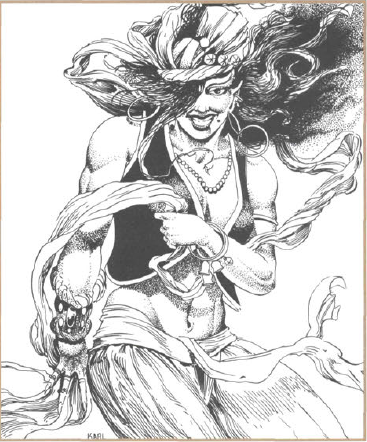
Zakharan Djinni Genies have the friendliest relationship with the Land of Fate’s mortals besides the janni. They live among floating islands in the Elemental Plane of Air, although their cities have architecture for nonflying visitors. Djinni society is much like the Caliphate’s, even down to identical noble titles and a Great Caliph of their own. Their settlements are autonomous but have mutual defense pacts to come to each other’s aid in times of danger. Those who visit the Material Plane prefer the natural beauty of the wilderness and tend to regard mortals as comical; they are quite fond of using their illusory and air magic to play practical jokes. They’re the most amenable to servitude by a sha’ir, but find longer-term contracts distasteful.
Statwise they are 7 Hit Die creatures capable of creating a rideable whirlwind to batter their foes and blow things around. Their magical powers are themed towards air, creating physical objects, and minor illusions.
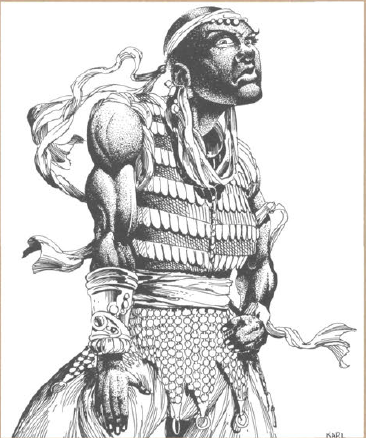
Zakharan Dao Genies are evil beings who live in the great caverns of the Elemental Plane of Earth. They enslave xorns and other natives to further excavate their holdings as well as use them as scouts if they have the ability to naturally move through the earth. The dao’s local settlements are known as mazeworks ruled over by a noble known as an ataman, who in theory pledge themselves to an emperor known as the Great Khan who rules over an empire known as the Sevenfold Mazework. Although punished when found out, more than a few individual mazeworks have managed to gain political independence. Their capital city is the Great Dismal Delve, rich in the trade of gems, precious metals, and slaves.
Dao are a hard-working race, eager to create new settlements, trade networks, and various plans of personal enrichment. For unknown reasons their race is bound to come to the aid of the yikaria when on the Material Plane. The dao hate having to serve the yak-men, and take out their anger on others while in service. But they’re capable of indirectly harming their masters under the right circumstances.
Statwise dao are 8 Hit Die beings whose spell-like abilities center around stone, the creation of magical walls, and detection-type divination spells. They can grant limited wishes once per day but with restrictions: they’re similar to the limitations of the efreeti, but additionally cannot grant their abilities to anyone with extraplanar heritage in their family tree (no cambions, planetouched, etc). Instead of being overseen by a bureaucracy, they can only grant a wish that will be twisted or bring misfortune. Even the dao cannot predict how said wish will be warped, although they are aware that their own wishes cannot be fulfilled as intended. Dao can also burrow through soil and soft earth, and are capable of lifting up to 500 pounds indefinitely without tiring.
Thoughts So Far: I feel that most of the bestiary are twists on existing monsters rather than new ones outright. I do not see what is much different in regards to Zakharan genies than the ones found in the core rules besides some mention of specific setting detail. The two giants are interesting from a fluff standpoint* but statwise you know more or less what you’re getting. The yak-men/yikarians are my favorite, and make for a good major villainous faction in al-Qadim campaigns with unique abilities to go along with them. Their mountain empire got an expanded treatment in Dragon #241, although I do not own that particular issue so comment further on it.
*I like the ogre giant’s cairns.
Concluding Thoughts: Al-Qadim still holds up well by modern standards, minus some dated 2nd Edition mechanics. It has enough unique features to make it stand out from other settings beyond the Arabian Nights aesthetic, and the various cities and regions have enough variation to host a diverse amount of campaign types. Courtly intrigue in the many cities, dungeon delving in the Ruined Kingdoms, and sailing the high seas of the Corsair Coast or Crowded Seas are but a few inspirational ideas which are not only supported, but expanded upon in further sourcebooks.
Al-Qadim’s major weakness is the datedness of the 2nd Edition ruleset, as I imagine most gaming groups would want to play it in the more modern 5th Edition. While the Land of Fate boxed set is mostly fluff, the class kits, magic items, and spells found in Arabian Adventures are a big part of the original campaign’s theme. Additionally there is a high-level bias on the part of many NPCs in power, although unlike the Forgotten Realms they are mostly confined to their individual domains. You don’t have Drizz’t or Elminster figures running around and saving the day to the point that you have to cook up excuses as to why the PCs are handling a crisis without their support.
I understand that this review was a long time coming ever since I polled the option two months ago, but I hope the wait was worth it. For my next review, we’re going to try something more modern and contemporary with SIGMATA: This Signal Kills Fascists.